How to get Nexus for fast-track entry to the US and Canada

Editor's note: This is a recurring post, regularly updated with new information and offers.
Trusted Traveler Programs help eligible travelers expedite their way through border security at U.S. airports and land and sea ports.
There is a lesser-known program, Nexus, for travelers who frequently cross the U.S.-Canada border. What's even less commonly known is that Nexus also includes a Global Entry (and thus a TSA PreCheck ) membership for just an additional $50.
Wondering if Nexus may be the right program for you? Here's everything you need to know.

How Nexus works
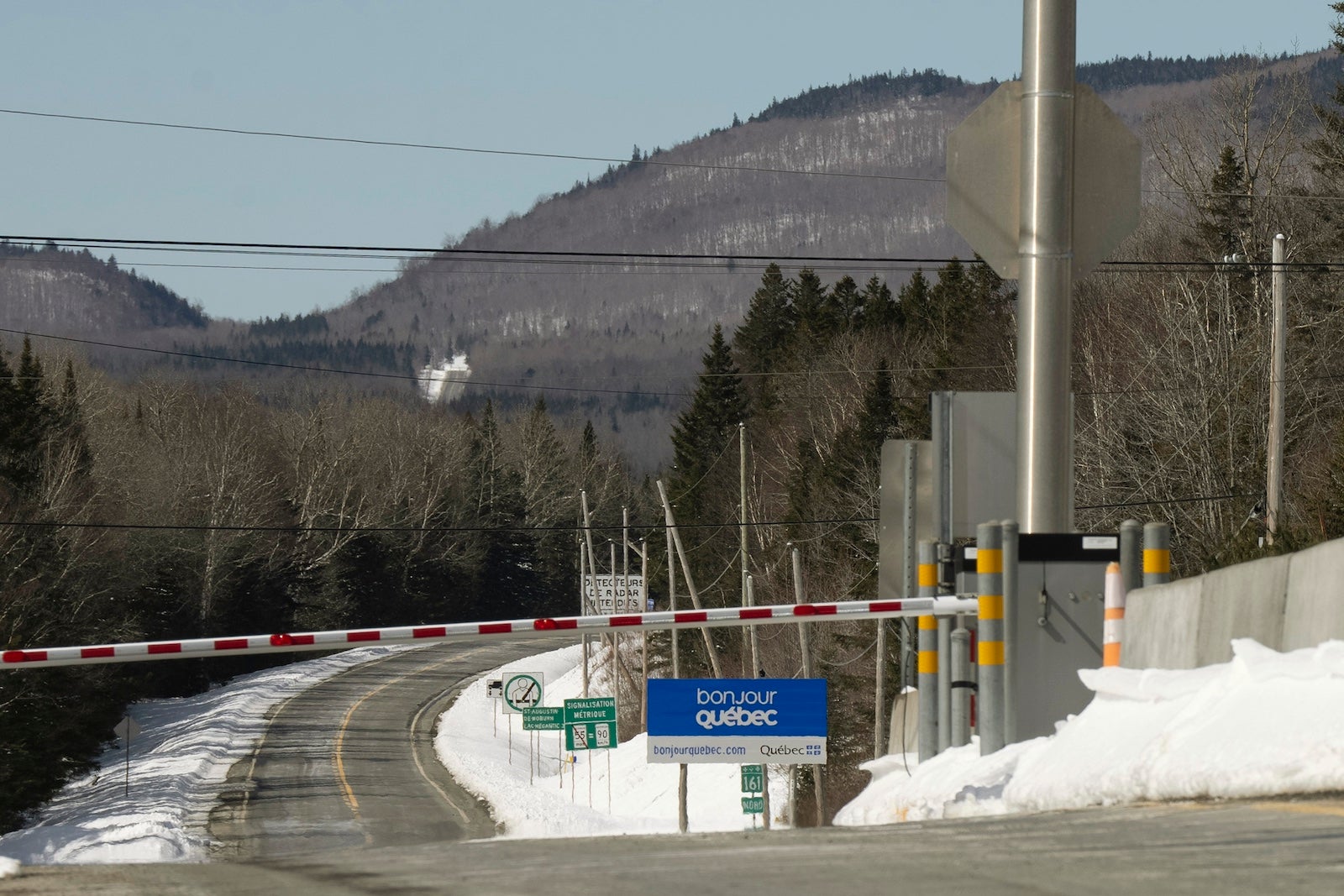
U.S. citizens, U.S. lawful permanent residents, Canadian citizens, Canadian lawful permanent residents and Mexican nationals who belong to Mexico's equivalent program (Viajero Confiable) are eligible for Nexus. Those under 18 must have the consent of a parent or legal guardian to participate.
Nexus provides prescreened travelers with expedited processing services when entering the U.S. and Canada by plane, car or boat. It uses Nexus-only processing lanes at designated entry ports along the northern border; Nexus kiosks when entering Canada by air; and Global Entry kiosks when arriving at one of nine Canadian Preclearance airports in Ontario, Quebec, British Columbia, Manitoba, Nova Scotia and Alberta. Global Entry cards provide Nexus access when entering the U.S. but are not valid for entry into Canada via Nexus lanes or kiosks.
The Nexus application process
Travelers can apply online for a Nexus membership, after which they'll be prompted to arrange an in-person interview at an enrollment center .
Currently, there are 15 enrollment locations in Maine, Michigan, Minnesota, Montana, New York, North Dakota, Vermont, Washington and Canada.
As of 2023, the average processing time for Nexus is 18 to 20 months, so plan accordingly.
Like the other Trusted Traveler Programs, a Nexus membership is valid for five years. Adult applicants must pay a nonrefundable $50 application fee.
The Canada Border Services Agency and U.S. Customs and Border Protection advise Nexus holders to renew their applications one year before expiration.
Upon approval, Nexus members receive a membership identification card via mail to use when entering Canada or the U.S. at designated Nexus entries.
To activate your Nexus card, simply log into your Trusted Traveler Program account and click the "Activate Membership Card" button in the "Program Membership(s)" section.
Once your membership is active, plan on keeping your card on you (plus your passport and/or proof of permanent residence) whenever you travel. The CBP advises this to ensure you can provide adequate proof of citizenship or permanent residence status if needed.
Should you lose your Nexus card, a $25 replacement fee will apply.
Enrollment on Arrival
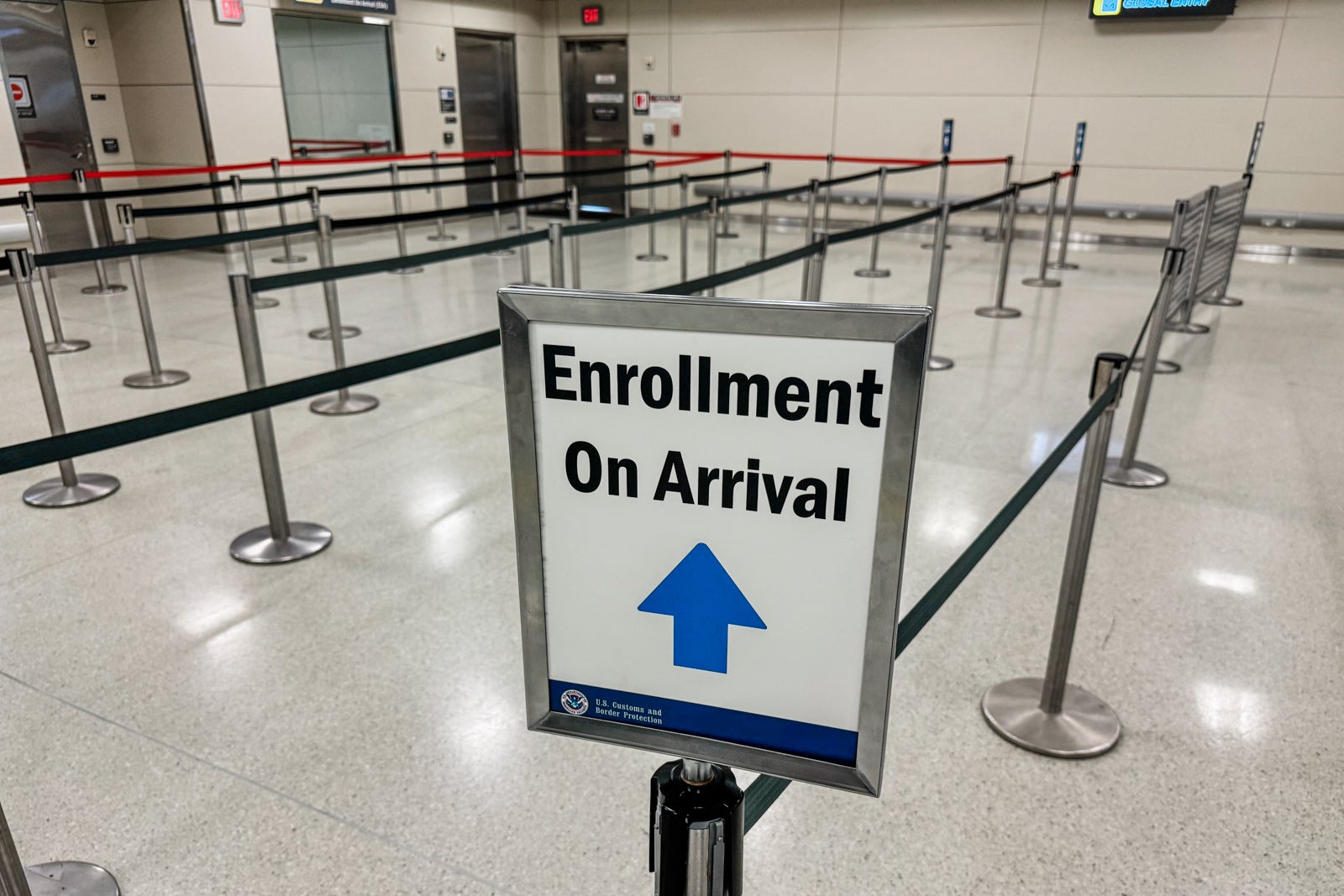
Like Global Entry, conditionally approved Nexus applicants can complete the interview step via Enrollment on Arrival upon returning to the U.S. by air, including from designated CBP preclearance locations.
This process allows conditionally approved applicants to complete their Global Entry and/or Nexus enrollment interview as part of the immigration process when arriving at the airport after an international trip. To do this, look for signs in the airport for the "Enrollment on Arrival" lanes. Also, be sure your flight arrives during the hours when interviews are offered.
A CBP agent will complete your Global Entry interview during your admissibility inspection.
Given that Nexus is a jointly administered Trusted Traveler Program, applicants interview with both CBP and the CBSA for approval.
This entails a two-step process. First, applicants must interview with the CBSA at Canadian airport enrollment centers to complete the Canadian portion of the interview process. Then, they must interview with CBP at designated Enrollment on Arrival locations.
All conditionally approved applicants are eligible to complete their CBP interview via Enrollment on Arrival at any participating U.S. airport or preclearance location, regardless of whether they have completed the CBSA portion of the interview.
Enrollment on Arrival interviews are offered on a first-come, first-served basis depending on the availability of relevant airport personnel.
Nexus includes Global Entry and TSA PreCheck
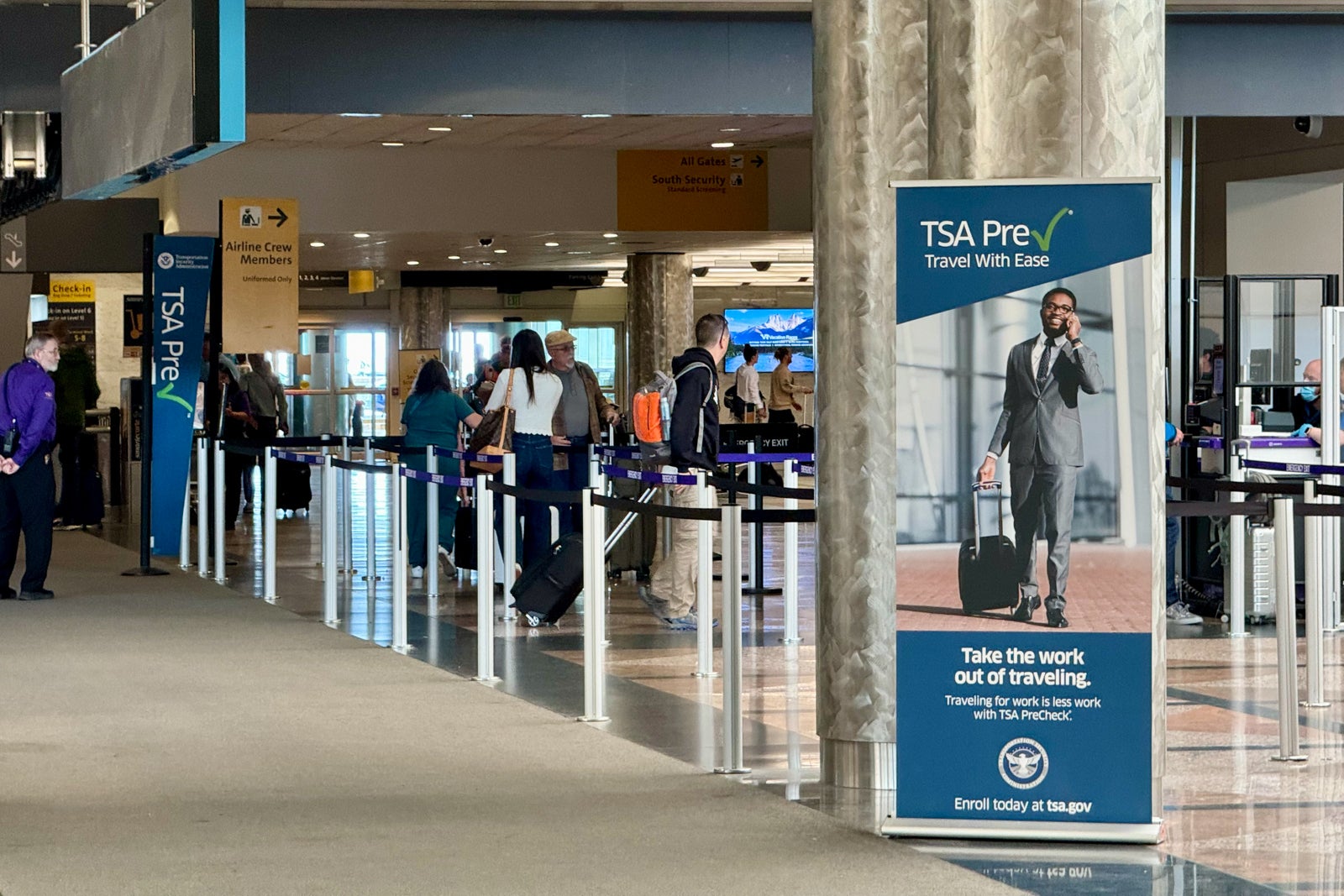
As mentioned above, a Nexus membership includes access to Global Entry and, thus, TSA PreCheck security checkpoints. TSA PreCheck is an expedited security program run by the Transportation Security Administration for preapproved, low-risk travelers. TSA PreCheck users pass through dedicated TSA PreCheck security lines at more than 200 U.S. airports without removing their shoes, laptops, liquids, belts and light jackets.
According to the U.S. Department of Homeland Security, by meeting Nexus eligibility requirements and sharing your passport information and fingerprints during your enrollment interview, you'll be eligible for Global Entry. The catch is that it's most beneficial for Americans living near the Canadian border, as only border locations will accept interview applicants.
The same rules apply to any other TSA PreCheck user, with Nexus or otherwise.
Once enrolled, you'll need to add your Known Traveler Number to your airline reservation. Then, when accessing your boarding pass, you should see a TSA PreCheck indicator. Presenting your boarding pass with this symbol is the only way to gain access to the TSA PreCheck lane.
Credit cards that reimburse Nexus fees
Several credit cards offer cardholders up to $100 in statement credit reimbursement for the application fees associated with TSA PreCheck and Global Entry (and, thus, Nexus), including:
- Capital One Venture X Rewards Credit Card
- United℠ Explorer Card (every four years)
- Chase Sapphire Reserve® (every four years)
- United Club℠ Infinite Card (every four years)
- IHG One Rewards Premier Credit Card (every four years)
- Capital One Venture Rewards Credit Card
- The Aeroplan® Credit Card
- IHG One Rewards Premier Business Credit Card
- Southwest Rapid Rewards® Performance Business Credit Card
- United Quest℠ Card
The price of Global Entry is increasing to $120 in October, so double-check whether your credit card issuer will increase its statement credit accordingly.
Bottom line
Eligible travelers can take advantage of Global Entry, TSA PreCheck and Nexus for half the price of a Global Entry membership. If you are an American, Mexican or Canadian citizen who frequently crosses the U.S.-Canada border, this program might be for you.
Related reading:
- Several Chase credit cards can reimburse your Nexus application fees
- 7 ways to get free or discounted TSA PreCheck, Global Entry and Clear
- Global Entry vs. TSA PreCheck: Which is more beneficial?
- Why you should get TSA PreCheck and Clear — and how you can save on both
Advertiser Disclosure
Many of the credit card offers that appear on this site are from credit card companies from which we receive financial compensation. This compensation may impact how and where products appear on this site (including, for example, the order in which they appear). However, the credit card information that we publish has been written and evaluated by experts who know these products inside out. We only recommend products we either use ourselves or endorse. This site does not include all credit card companies or all available credit card offers that are on the market. See our advertising policy here where we list advertisers that we work with, and how we make money. You can also review our credit card rating methodology .
NEXUS Trusted Traveler Program – Applying, Eligibility, Benefits & More [Detailed]
James Larounis
Senior Content Contributor
567 Published Articles 1 Edited Article
Countries Visited: 30 U.S. States Visited: 35
Keri Stooksbury
Editor-in-Chief
41 Published Articles 3364 Edited Articles
Countries Visited: 50 U.S. States Visited: 28
![nexus travel to usa NEXUS Trusted Traveler Program – Applying, Eligibility, Benefits & More [Detailed]](https://upgradedpoints.com/wp-content/uploads/2019/05/Nexus-Global-Entry-sign-at-airport.jpg?auto=webp&disable=upscale&width=1200)
Table of Contents
What is nexus, how does the nexus program work, about nexus eligibility, benefits of nexus, how to apply for nexus, security screening, what is the nexus interview like, where to apply: nexus enrollment centers, where can you use your nexus card, nexus cost information, nexus cards, nexus card legal status, nexus kiosk instructions, card replacement, traveling with non-nexus individuals, how much time you can save with nexus, countries that participate in the nexus program, traveling with pets, items permitted in nexus lanes, global entry vs. nexus, final thoughts.
We may be compensated when you click on product links, such as credit cards, from one or more of our advertising partners. Terms apply to the offers below. See our Advertising Policy for more about our partners, how we make money, and our rating methodology. Opinions and recommendations are ours alone.
The Department of Homeland Security (DHS) has Trusted Traveler programs that can help you move through ports of entry or airport lines more quickly . If you’re a frequent traveler who visits Canada for business or pleasure, there’s a special program for you.
NEXUS provides a modified screening process for pre-approved members . In addition, it improves security via more efficient screenings while also facilitating legitimate travel and trade.
If you’re looking to beat the long lines, we’ll answer your questions about the NEXUS program’s advantages, and point you in the right direction for signing up. Soon you’ll be zooming through customs and getting to your destination a lot faster — and with way fewer headaches.
If you’ve never heard of it, basically NEXUS is a program that allows pre-screened travelers to use expedited processing when entering Canada or the U.S.
- Members can use dedicated processing lanes at specific border ports of entry
- There are NEXUS kiosks for air entry to Canada (as well as Global Entry kiosks for U.S. entry at certain Canadian pre-clearance airports)
- NEXUS members can receive expedited processing when arriving by sea at some locations
To avoid long waits, NEXUS members’ information is stored in a special database. When a member enters the country at a participating airport (or other port of entry), their membership card and fingerprints are scanned at a kiosk, they fill out a customs declaration form, and they can go straight to the baggage claim area.
The NEXUS program is 1 of 5 Trusted Traveler programs available, 4 of which are designed for both business and personal travelers:
- Global Entry
- TSA PreCheck
The fifth program, FAST, is designed for commercial trucking.
Bottom Line: NEXUS can save time, lower stress, and simplify travel by allowing its members to skip the normal lines for customs entry and arrive at their destination much faster.
NEXUS allows expedited entry into the U.S. and Canada via kiosks and marine entry points. Instead of waiting in line to speak with a customs officer, NEXUS cardholders simply answer a series of standard questions in electronic form and can then enter the country without having to pass through a manned checkpoint.
That said, NEXUS does not absolve you from having to speak with a human. You can be selected for random screening at any point, and your bags or personal belongings can be examined. However, a majority of the time, you’ll be let into the country without further processing.
To take advantage of domestic TSA PreCheck benefits, NEXUS members need to enter their membership number in the Trusted Traveler number field when they book a flight (or add it to their frequent flyer profile). That membership number gives TSA the ability to proceed with Trusted Traveler verification.
Hot Tip: Your NEXUS program number is your Trusted Traveler number. When purchasing your airline ticket, enter your NEXUS number to receive TSA PreCheck benefits.
Where to Find Your Membership Number
Your member number can be located by logging into your account on the Trusted Traveler Program website . It can also be found on the back of your card.
Not everyone is eligible for NEXUS, and there are certain categories of people who can and can’t apply.
Who’s Eligible?
Eligible parties include the following:
- U.S. citizens
- U.S. lawful permanent residents
- Canadian citizens
- Canadian lawful permanent residents
- Mexican nationals (members of Viajero Confiable, Mexico’s Trusted Traveler program)
Anyone under the age of 18 must have written consent from a parent or legal guardian for participating in the program in addition to meeting the eligibility requirements above.
Hot Tip: There is no fee to apply for NEXUS for minors under the age of 18, but they must still complete an application.
If you’re in a family with more than one person applying, including a minor, we suggest that you apply at the same time and do your interview on the same day.
Nexus Restrictions and Ineligibility Reasons
You might not be eligible for participation in the NEXUS program if you:
- Provide incomplete or false information on your application
- Were convicted of a criminal offense or have outstanding warrants or pending criminal charges (including DUI)
- Are in violation of any agriculture, customs, or immigration laws or regulations in any country
- Are the subject of any ongoing investigation(s) by any local, state, or federal law enforcement agency
- Have been denied the purchase of a firearm
- Have received a criminal pardon (in any country)
- Are inadmissible to the U.S. under any immigration regulation (includes applicants with parole documentation or approved waiver of inadmissibility)
- Are unable to satisfy Canada Border Services Agency or CBP regarding your low-risk status
Hot Tip: Both the U.S. and Canada need to approve your application ; application denial by either country will result in the denial of your participation in the NEXUS program .
It’s important to understand that not every criminal act will get your NEXUS application denied. You may still be approved, and there are several things you can do to help improve your chances.
Let’s take a look at each of the qualifications for possible denial, your chances of being approved, and what you can do to help your situation. To be clear, this is not legal advice or a guarantee of approval — but it is worth mentioning since there are many people who may apply with some sort of demerit on their record.
- If you provide incomplete information on your NEXUS application, you may be given a chance to update that information during your interview, so long as it is determined that you did not omit it purposely. Always double-check your application to be sure all information is complete.
- If you provide false information on your application, there is almost no chance you will be approved. This shows you cannot be trusted to answer the arrival questions honestly at a port of entry.
- If you have been convicted of a criminal offense , you won’t necessarily be denied. It depends on the severity of the crime and how long ago your conviction was. You generally stand a better chance of approval if the crime was over 10 years ago.
- If you have any pending criminal charges , you likely won’t be approved.
- If you have been convicted of a DUI , the chances you will be approved are very slim. The Canadian government takes driving under the influence cases much more seriously than the U.S. That said, there is some anecdotal evidence of successful approval with a previous DUI arrest.
- If you’re in violation of any agriculture, customs, or immigration laws , there is almost no chance you will be approved. NEXUS is a cooperative agreement between the U.S. and Canada, and both countries take these violations seriously. In fact, these offenses are taken more seriously with NEXUS than with Global Entry, since NEXUS involves access into 2 countries.
- If you are inadmissible to the U.S. for any reason , you will not be approved for a NEXUS card. This could include previous violations, customs issues, or immigration issues.
- As a general blanket statement, if you are unable to prove to either country that you are a low-risk traveler , you will not be approved.
If you have questions before applying, we recommend you speak with an immigration attorney or another professional familiar with the approval process.
Bottom Line: Just because you have a criminal conviction doesn’t mean you’ll be automatically denied, though it certainly reduces your chances of being approved.
NEXUS program membership allows you to have reduced waiting times at designated ports of entry by allowing you to:
- Use dedicated land border crossing processing lanes
- Use NEXUS kiosks when you enter Canada via airport
- Use Global Entry kiosks when you enter the U.S. via airport
- Call a marine telephone reporting center for reporting your arrival in the U.S. or Canada
There are several obvious perks here. First, when you can use the dedicated land border crossing processing lanes, you’ll experience a shorter wait when entering either country by vehicle.
At the airport, by using a NEXUS kiosk, you’ll avoid having to use the manual admission kiosks and can proceed straight to a customs officer for presentation . This avoids the inevitable long lines, especially at busy airports such as Toronto Pearson.
Hot Tip: Even when you use a NEXUS kiosk, you still present a verification printout to an officer at the exit — but generally these officers will simply waive you through without additional questioning.
When you use a Global Entry kiosk to enter the U.S. by air, you won��’t have to fill out the paper customs declaration form or have a formal interview with an officer (where you approach the row of “cubicles” where they sit).
Instead, you’ll go right to the Global Entry kiosks, answer a few questions, and then give the printed slip to the border officer at the end of the process.
For seaport entries, calling the marine telephone reporting center lets you avoid having to physically present yourself to an officer through an official customs station. Instead, you can simply declare yourself and any goods over the phone.
There are 2 ways to submit a completed application:
Apply Online (Fastest Way)
Step #1: Create your Trusted Traveler Program (TTP) account .
Step #2: Logging in to your TTP account, you can then complete your application and pay your $50 fee, which is non-refundable and required with all completed applications.
After acceptance of your completed application with the required fee, CBP reviews your application. If it is conditionally approved, you’ll be instructed to schedule your interview at any NEXUS Enrollment Center.
This is by far the easiest way to enroll in the NEXUS program since it can be completed online. You can also track your status online and see where you are throughout the process, as well as any approvals or rejections.
Apply by Mail
The Canada Border Security Agency no longer allows paper applications for the NEXUS program. Previously, Canadian residents were able to print out an application and submit it by mail, but this is no longer the case.
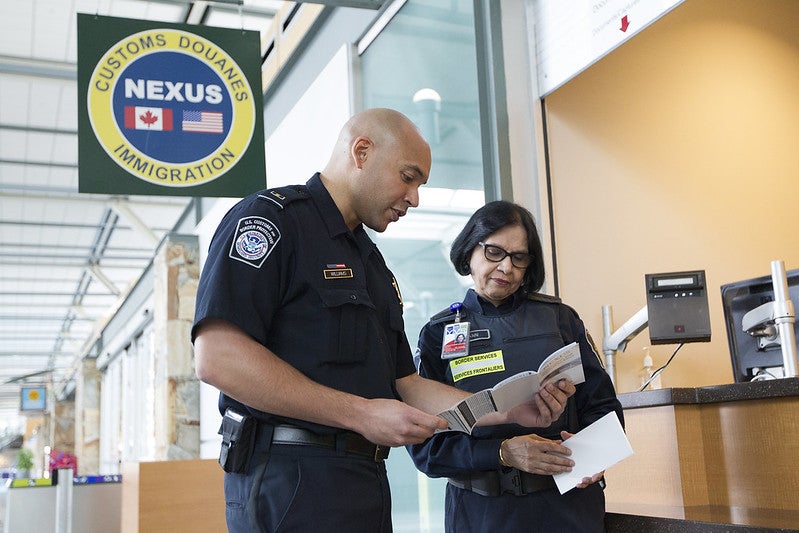
Applicants will undergo screening for their immigration status and citizenship, as well as a check for any possible criminal history and/or positive match on the following databases:
- Canadian Security Intelligence Service (CSIS)
- Interpol terrorism and no-fly list
- United Nations databases
- The UK Police National Computer
- U.S. Federal Bureau of Investigation (FBI)
- Royal Canadian Mounted Police (RCMP)
As a reminder, it is very important you do not lie on your application, even about minor criminal activity . Because the background check is so thorough, anything you try to hide will be discovered.
Applying for a NEXUS card is similar to a government background check to work at the Pentagon, for example — it covers all bases to ensure you’re safe to proceed into the country without risk of hiding something.
Applicants who pass the initial screening will then have an in-person interview with both the Canadian Border Services Agency and U.S. CBP.
Following approval, new members will receive an RFID-enabled NEXUS card in the mail, which is valid for 5 years from their next birthday following issuance. Renewal generally occurs 90 days prior to the card expiration date.
Upon renewal, another interview to verify your continued qualification may be required.
Part of the requirement of the NEXUS program is to present yourself in front of both a CBP and CBSA officer. This is done for a few reasons, but partly so they can take your fingerprints and picture, match your information against their databases, and have the opportunity to question you on any discrepancies.
In general, you can expect several questions throughout the interview process that you should be prepared to answer:
- Why do you want the NEXUS card? It’s okay to be honest and say you’re doing it because it’s a cheaper option than Global Entry, but you only intend on using it for admittance into the U.S. If you’re truly going to enter both Canada and the U.S., you will want to explain your frequency of travel between the countries, how you usually get between them, and what your business is on either side.
- You’ll be asked to detail your line of work . This is important so customs officials know you’re not using the program to gain entry into either county to live or work illegally. This question won’t be too complex.
- You may be asked about any previous interactions at the border and if you’ve ever brought over anything you shouldn’t have, such as food. Saying you have won’t necessarily disqualify you, but it may show you’re an honest person.
- You may be asked what countries you have traveled to . The officer is trying to see where outside the U.S. and Canada you have been, and if any of the countries on your list have bad relations with the U.S. or Canada. This could signal potential terrorist activity, so officers will want to know why you were in those countries specifically. There are many people who have traveled to Iraq or Iran for tourism — if you have visited there or any other potentially risky countries, just be forthcoming in your response and state why.
- You may be asked how you usually travel to any countries you have visited outside the U.S. or Canada. The officer is looking to see what modes of transportation you frequently use, who may pay for your tickets, and how you get around once in a foreign country. This answer helps them get a big-picture look at how you normally travel.
- You may be asked why you applied for NEXUS vs. applying specifically for Global Entry. In this case, state why you visit Canada frequently or want expedited processing there. Many travelers report that they travel to Canada for work, or even to fly out of a cheaper airport.
- You’ll be asked to confirm your personal details , including your home address, personal biographical information, phone number, etc. They want to confirm you know what you put on your application, and where to send the card and informational packet if you are approved.
- You’ll be asked about any business dealings you have on either side of the border , which can represent an issue for customs. Do you manufacture goods in one country and export them? Do you produce fresh food in one country and intend on bringing it across the border? They’ll also see if you have employment in either country and how that affects any trade.
- If you have criminal convictions or other things that may arise , you’ll be asked about each of these in detail. If you’re asked for details about a specific crime, be very open and honest — do not lie about anything. Make sure you inform them of the dates of the crime, what you did, whether you were found guilty, any punishments, and what has happened since the infraction. If you’ve gone into a rehabilitation program, had a record expunged, etc., these are very important details to offer.
Many people ask what the dress code is for this interview. It’s not formal, so there’s no need to show up in your Sunday best, but you should be presentable. For men, that may be a polo-style shirt or casual button-down. For the ladies, a sweater or professional top should work great.
Hot Tip: You’ll have your picture taken at your interview for printing on your NEXUS card, so you should wear whatever you’d like to see in your picture for the next 5 years!
It’s also worth noting that your dress does represent who you are — if you have previous criminal convictions or any problems with your application, you’ll want to dress to impress. While wearing a t-shirt and jeans won’t necessarily get you denied, wearing something presentable lets the interviewing officer know you’re serious about following the terms and conditions of membership.
Most reports of the interview process suggest you should allow for about a 15-minute meeting. Depending on the wait at the facility, you may be asked to be seated until you are called, but many interviewees indicate this was a relatively short process.
NEXUS Enrollment Centers are located in several states in the U.S. as well as in Canada.
Canadian NEXUS Enrollment Centers:
- Buffalo-Fort Erie, Ontario
- Calgary International Airport
- Edmonton International Airport
- Halifax Stanfield International Airport
- Landsdowne, Ontario
- Montreal-Trudeau International Airport
- Ottawa Macdonald-Cartier International Airport
- Toronto Pearson International Airport
- Vancouver International Airport
- Winnipeg Richardson International Airport
U.S. NEXUS Enrollment Centers:
- Blaine, Washington
- Buffalo, New York
- Calais, Maine
- Champlain, New York
- Derby Line, Vermont
- Detroit, Michigan
- Houlton-Woodstock, Maine
- International Falls, Minnesota
- Niagara Falls, New York
- Pembina, North Dakota
- Port Huron, Michigan
- Sault Ste. Marie, Michigan
- Sweetgrass, Montana
- Warroad, Minnesota
You’ll notice that all of these interview points are located along the Canada/U.S. border, and many of them aren’t at obvious locations (such as airports).
So how should you do a NEXUS interview if you don’t live along the border or near one of the interview points? After all, just because you don’t live near the border doesn’t mean you might not visit Canada frequently.
Many travelers plan their air travel trips to connect or end at one of the interview points on either side of the border. For example, you might connect or end a trip in Seattle. This lets you avoid having to drive far distances or plan on an overnight adventure just to complete the interview process.
To clarify, you don’t have to schedule 2 separate interviews at 2 separate locations — you schedule 1 interview at an enrollment center and are interviewed there by both Canadian and U.S. officials.
How Long Is the Whole Application Process?
The entire NEXUS application process can end up taking anywhere from 12 to 14 months depending on the current application and interview backlog.
Your initial application will only take about 20 to 30 minutes to complete, but conditional application approval can take months — and booking your interview could take even longer.
Things That Can Speed Up Your Application:
- Easily verifiable history
- No criminal convictions
- No blemishes on your application
Things That Can Slow Down the Application Process:
- History that isn’t verifiable (for example, a reported address for which the government has no record)
- Criminal history
- Missing information from your application
Hot Tip: Be honest and thorough on your application. If you omit anything, even if by mistake, it could slow down the processing of your application.
Here is a complete list of airports with kiosks, as well as those that only offer priority security screenings. Priority screening means that while there’s no full NEXUS kiosk setup, you will receive priority security access when leaving or arriving to help you avoid waiting in long lines.
Essentially, because you’re a Trusted Traveler, they’ll assume you have a lower risk of bringing in or departing with any contraband.
You’ll also find a listing below of available land border crossings and marine crossing details.
Airports With NEXUS Kiosks
You will find NEXUS kiosks at these airports:
- Billy Bishop Toronto City Airport (YTZ)
- Calgary International Airport (YYC)
- Edmonton International Airport (YEG)
- Halifax Stanfield International Airport (YHZ)
- Montreal Pierre Elliott Trudeau International Airport (YUL)
- Ottawa Macdonald-Cartier International Airport (YOW)
- Toronto Pearson International Airport (YYZ)
- Vancouver International Airport (YVR)
- Winnipeg James Armstrong Richardson International Airport (YWG)
These airports have priority security screening only:
- Greater Moncton Roméo LeBlanc International Airport (YQM)
- Kelowna International Airport (YLW)
- Québec City Jean Lesage International Airport (YQB)
- St. John’s International Airport (YYT)
- Saskatoon John G. Diefenbaker International Airport (YXE)
- Regina International Airport (YQR)
- Victoria International Airport (YYJ)
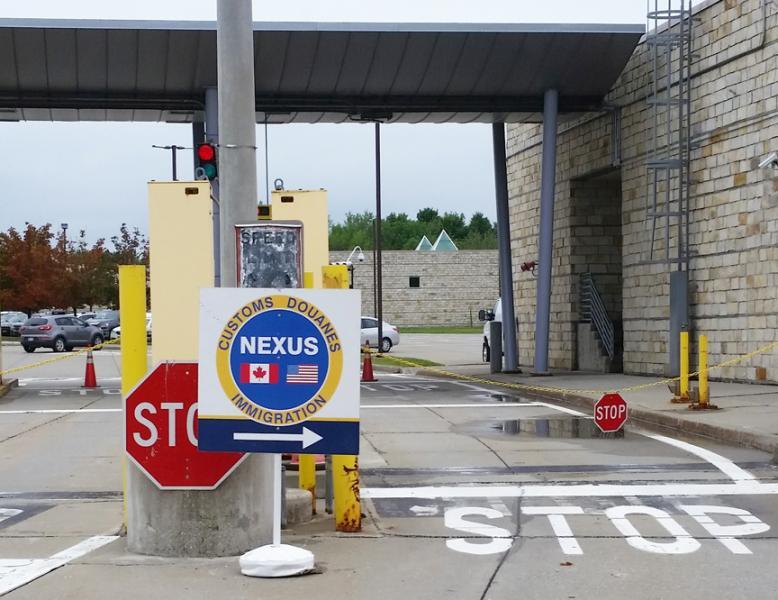
NEXUS Marine Crossings
NEXUS members have the opportunity for reporting to nearly 400 designated sites in Canada or the U.S. by calling CBP/CBSA between 30 minutes and 4 hours prior to arriving. Though the system is simplified, you’ll still need to provide the appropriate declarations and other specified information.
For those not familiar, essentially it’s possible to arrive in Canada or the U.S. by hundreds of different marine locations. You could take a boat from the U.S. into Canada or vice versa — because that boat doesn’t have to go through a specifically marked border crossing, it is essentially allowed to cross the border with the understanding that once it reaches land, the passengers onboard must declare themselves and their belongings.
NEXUS Land Border Crossings
NEXUS lanes can be found at these land border crossings :
- Alexandria Bay, New York
- Blaine, Washington (Pacific Highway and Peace Arch)
- Buffalo, New York (Peace Bridge)
- Detroit, Michigan (Ambassador Bridge and Detroit-Windsor Tunnel)
- Highgate Springs, Vermont
- Houlton, Maine
- Niagara Falls, New York (Lewiston Bridge and Whirlpool Bridge)
- Point Roberts, Washington
- Port Huron, Michigan (Blue Water Bridge)
- Sault Ste. Marie, Michigan (International Bridge)
- Sumas, Washington
Entering Canada by Land
Participating Canadian land border crossing points usually have a single lane that is reserved solely for use by NEXUS members. Some border crossing points will designate a second NEXUS lane on an as-needed basis depending on the volume of entering traffic.
Vehicles are only allowed to utilize the NEXUS lane if each passenger (including children) has a valid NEXUS card. This is something that trips many travelers up and can get them into trouble.
Some drivers believe that because they hold a NEXUS card it allows them to use the expedited lanes, even though other passengers in the vehicle do not have clearance. But this can actually slow down your processing dramatically, as the vehicle will need to move to a regular lane so everyone inside can be screened.
If you’re traveling with other non-NEXUS passengers, here are your options:
- Take 2 vehicles: one vehicle for NEXUS cardholders, and the other for non-NEXUS travelers
- Take 1 vehicle, but go through the traditional non-NEXUS checkpoint
In addition, all passengers must not bring anything that requires a duty payment or special customs declaration — this would require you to go through the traditional lanes to officially declare them with an officer.
Bottom Line: Don’t use the NEXUS lanes unless every passenger in your vehicle has NEXUS and isn’t carrying anything they need to declare.
Entering the U.S. by Land (from Canada and Mexico)
NEXUS cards are valid at all RFID-ready lanes found at land crossings into the U.S. from Canada, and vice versa.
At the Mexican border, NEXUS members can use SENTRI lanes when they enter the U.S. via car, but they must be traveling in a registered and approved vehicle — you can’t be driving a rental car that’s not registered to your account. This is because the SENTRI program requires registration of vehicles, which involves thorough inspections by the CBP.
Whether travelers are in approved vehicles or not, NEXUS cards are always WHTI-compliant documents and can be utilized in all standard lanes entering the U.S. from Mexico as proof of citizenship and identity . In addition, pedestrians can utilize the dedicated SENTRI lines for accessing expedited entry at the San Ysidro border crossing from Tijuana to the U.S.
How Much Does NEXUS Cost?
Application fee (nonrefundable).
A $50 one-time fee will be required with your NEXUS application. It must be paid in full with your application submission via the Trusted Traveler Program System (credit card or electronic bank transfer).
Note that this fee is non-refundable even if your application is denied .
Paying for Membership
Frequent travelers will be accustomed to the reimbursement of fees with Global Entry or TSA PreCheck from premium credit cards . However, Chase is the only credit card issuer that will reimburse Nexus fees. Here are a few of the cards where you can find this coverage:
- Chase Sapphire Reserve ®
- United Quest℠ Card
- United℠ Explorer Card
- Aeroplan ® Credit Card
If approved for participation in NEXUS, you will receive a radio frequency identification (RFID) card for use when entering the U.S. or Canada at all designated NEXUS land, air, and marine ports of entry.
Activating Your NEXUS Card
Log in to your account on the Trusted Traveler Program website, and then click on “Activate Membership Card” at the bottom of the Program Membership section. You’ll need to enter information from your card to finalize the process.
How To Use Your NEXUS Card
Land Borders
To Enter Canada:
Use a designated NEXUS lane by stopping and holding your membership card directly in front of a card reader. Then, proceed to the inspection booth for your visual inspection. A border officer will specify whether you should proceed into Canada or enter the inspection area.
To Enter the U.S.:
In a designated NEXUS lane, stop and hold your membership card directly in front of a card reader. Then, head to the inspection booth for your visual inspection. You may proceed into the U.S. unless directed to an inspection area.
NEXUS members using air travel as their mode of transportation can enter Canada via the self-serve kiosks no matter where they’re coming from. For example, NEXUS members returning from overseas to Canada via Montréal are permitted to use a self-serve kiosk upon arrival in Montréal.
Use Global Entry kiosks within the customs area and follow the designated prompts on the screen. There is usually no wait for these kiosks — if there is, it usually moves pretty quickly.
Once you are finished answering the questions on the screen, scanning your fingerprints, and having your picture taken, you’ll get a printout to give to a CBP officer at the exit point. Then may ask simple questions about your visit abroad, though in most cases you can proceed beyond that point without any further inquiry.
A NEXUS Trusted Traveler card is a valid document in the U.S. under the Western Hemisphere Travel Initiative (WHTI). As such, it may be used on its own for reentering the country from Canada by air. NEXUS cards issued after September 2010 will be accepted as proof of citizenship, so a passport is no longer required.
In addition, NEXUS membership cards are acceptable proofs of identity for confirming citizenship upon entering Canada at any marine or land port of entry. This means that U.S. or Canadian citizens who are NEXUS members with valid membership cards aren’t required to carry additional documents (i.e., birth certificate or passport) for entering Canada by land or boat, even when using a non-NEXUS lane.
Hot Tip: A NEXUS membership card is also acceptable as a List B identity document for use on a form I-9 employment verification.
- Have your NEXUS card ready
- Select your language of choice
- Insert your card into the document reader when prompted
- Make sure it’s face up (picture side) and fully inserted
- Leave your card in the reader until you are instructed to remove it
- When you receive audio instructions that advise you to look in the mirror, use the arrows to adjust and ensure you can see both eyes
- Looking into the mirror, move slightly back or forward until you see the circle is centered between your eyes and is changing from orange to green
- Follow all on-screen instructions and answer all questions displayed on the monitor
It’s important to make sure you are answering all questions correctly — don’t glance over things too quickly. Read all the questions presented carefully; once you confirm your answers, it is essentially legally binding. If a customs officer finds something you didn’t report, it could cause issues with your processing.
A nonrefundable $25 fee will be charged for replacing any NEXUS card that is lost, damaged, or stolen.
In the event that you’re traveling with any person(s) into the U.S. or Canada who are not NEXUS members, you must use the regular lanes.
If everyone traveling with you (including children) is a member as well, then you can all proceed to the NEXUS lane.
Usually, NEXUS cardholders are screened faster than non-NEXUS cardholders when crossing U.S. and Canadian borders where NEXUS, SENTRI, and Ready lanes are available. However, you will still be subject to any/all standard customs and immigration checks, and you could still be chosen for a secondary screening.
While exact times vary based on the date and time you’re traveling, we’ve compared some average wait times at major border crossings, you’ll see that NEXUS can save you some significant time!
NEXUS is one of 3 travel programs offered to frequent travelers who cross the border between Canada and the U.S.
Thus, the program has no benefit to visitors from any country other than the U.S. and Canada . For example, it has no use entering the European Union, Australia, countries in South America, or Asia. You’d only want to apply for the NEXUS program if you frequently cross borders with immediate U.S. neighbors.
Most domestic pets are allowed to be taken through dedicated NEXUS lanes both at NEXUS kiosks and at land border crossings. However, birds and other prohibited animals aren’t allowed in any NEXUS lanes.
All NEXUS members must be in possession of their pet’s valid rabies vaccination certificate that has been dated and signed by a licensed veterinarian. This certificate must:
- Clearly identify your animal by age, coloring, breed, sex, and any distinguishing marks
- Include the name, serial number, and expiration date of the vaccine utilized. (You can obtain this from a veterinarian.)
- The vaccination’s validity period (must not be expired)
Hot Tip: Don’t miss this study on the best and worst U.S. airlines to fly with your pet .
Other Pet Travel Facts:
- Pet tags will not be accepted in lieu of certificates.
- Kittens and puppies under 3 months of age don’t require rabies vaccination certificates, but proof of age is recommended. Usually, paperwork from a veterinarian suffices for this purpose. If you have questions on what type of paperwork can be used for this, speak with your animal’s medical professional.
- Pets that are used for commercial purposes (like racehorses or breeding animals) are considered commercial importations and are not allowed in any NEXUS lanes.
If you’re bringing an animal with you that falls outside of these requirements and restrictions, you won’t be able to use the expedited NEXUS lanes and will need to speak with an officer.
Humans should also check that they don’t need a vaccination! Check out our in-depth guide on Travel Vaccinations and Travel Health for all the details.
Certain items will be permitted when using NEXUS lanes, including:
- Alcohol in an amount that is within a member’s personal entitlement (depends on how long you are visiting)
- Tobacco products bearing the marking “Canada-Duty Paid”
- Any gifts worth up to $60 each (entering into Canada) or up to $100 total (entering the U.S.)
- Any reasonable amount of personal effects
Be very careful about what you’re reporting when you enter a checkpoint or kiosk. You may be asked if you’re carrying any food, which can include fruit, bags of chips, snacks, or other common household goodies. Even if you simply bought these in Canada or the U.S., ensure you report them fully.
This includes items you may have taken from an aircraft or lounge. Be sure you remember if you’ve taken something — many travelers unknowingly stick fruit or other food items in their backpack and forget about them, but later get caught at customs as dogs and other teams are trained to detect food items not declared.
When in doubt, declare. If you can’t remember whether you have something, but there’s a chance you do, report it — this way you’re not hiding anything. If you have food on you that isn’t reported and a customs officer finds it, this could be grounds for additional search — or possibly removal from any and all Trusted Traveler programs including NEXUS, Global Entry, and TSA PreCheck.
Hot Tip: You don’t want to have to fight this type of claim, so it’s better to be safe than sorry. It is extremely difficult to get your Trusted Traveler membership back once it has been revoked, and it is a very lengthy administrative process.
NEXUS actually includes Global Entry , though it’s important to talk about the differences between them so you can see what you’re applying for. Both programs are similar in premise, but the countries you can access are different.
Global Entry provides expedited pre-screened access only for entry into the U.S. , so it wouldn’t work for someone leaving the U.S. into Canada, for example. NEXUS includes expedited pre-screened access across both the Canadian and U.S. borders, which is why it requires approval from both governments.
About TSA PreCheck
For clarification, it’s important to briefly talk about TSA PreCheck and how it differs from the NEXUS program as well. PreCheck entitles travelers to bring liquids under 3oz. in their bag (without removing them), keep laptops in their bag, keep light jackets on as they walk through the metal detector, and keep shoes on.
Hot Tip: Remember that NEXUS gets you Global Entry which gets you PreCheck, so it’s an invaluable perk when using airport security facilities in the US.
PreCheck was launched in October 2011 and is currently available to many elite members of participating airlines’ frequent flyer programs, as well as members of Trusted Traveler programs (like NEXUS) who are U.S. citizens and flying on participating airlines. Active-duty military members are also eligible to use PreCheck.
Many airlines currently participate in the PreCheck program, and the TSA says it is working with other airlines to enroll them as well.
Eligible travelers will have their information embedded in a boarding pass barcode. However, even a traveler approved for PreCheck is subject to a random search and/or security screening.
Bottom Line: If you have NEXUS, you will receive TSA PreCheck benefits. But it doesn’t work both ways — if you only have TSA PreCheck, you will not have NEXUS benefits.
People who travel frequently overseas know just how difficult it gets to pass through customs upon arrival. NEXUS goes a long way toward lessening that pain while also dealing with an ever-expanding number of security risks. That’s why the U.S. government created the Global Entry and NEXUS programs for providing pre-approved clearance to travelers who are low-risk when entering the U.S.
If you travel between the U.S. and Canada often, this program could save you a tremendous amount of time.
Related Posts

UP's Bonus Valuation
This bonus value is an estimated valuation calculated by UP after analyzing redemption options, transfer partners, award availability and how much UP would pay to buy these points.
- Search Please fill out this field.
- Newsletters
- Destinations
- More to Explore
How to Apply for a NEXUS Card
ehrlif / Getty Images
The NEXUS Card gives U.S. and Canadian citizens pre-approval when entering Canada or the United States at all participating NEXUS air, land and marine ports of entry. Picture a massive line up at the Canadian border , either at the airport or at a land crossing, and you and your NEXUS card simply pass by everyone to get into the tiny "NEXUS Card" line. You can save hours.
Anyone can apply for a NEXUS card. You don't even need to travel often, just as long as you're willing to pay the cost and can attend the interview.
The NEXUS Card application process involves completing a questionnaire to determine eligibility, paying a fee and attending an interview.
Successful applicants, once they've received their cards, can take advantage of faster, more efficient Canada/U.S. border crossings at participating airports , vehicle crossings, and waterways.
Difficulty: Average
Time Required: 1 hour to complete application, 8 weeks+ to receive your NEXUS card
Here's How
- Register as a New GOES User: Go to the Trusted Travelers Program , which is the online enrollment system for NEXUS Card applicants. (Alternately, you can print off a hard copy NEXUS Card application at Canada Border Services and mail the application in.)
- To register as a GOES user, you must complete some basic information and create a password, which you should write down or store.
- Login and Complete the NEXUS Card Application: Once you've registered as a GOES user, you will be given a unique GOES User ID. Again, write down or store this ID. It will also be emailed to the email address you provided when registering. The NEXUS Card application involves answering questions about personal attributes, residency, citizenship, employment history, travel history, criminal record, etc.
- You will be asked for such things as passport , driver's license or visa numbers, so have these documents handy.
- Submit your NEXUS Card Application Fee: The final part of the online NEXUS application process is to submit a non-refundable fee by credit card or from a U.S. bank account.
- Schedule an Interview: After you've submitted your application and paid the fee, you will receive an email telling you if your application has been conditionally qualified or not. This takes at least 6 to 8 weeks (mine took 10). If you conditionally qualify, you will be asked to schedule an interview with at an enrollment center, most of which are located at border crossings or airports. The NEXUS Card interview involves answering basic questions about your NEXUS Card application as well as an iris scan and photo. You will be interviewed by two border control officers, one from Canada and one from the U.S.
- The interview process takes about 30 to 45 minutes but builds in wait times.
- Wait for 7 to 10 Days for Your Card to Arrive: You should receive your NEXUS Card in the mail 7 to 10 days after a successful interview. Some enrollment centers may be able to provide your card at the interview.
- Kids 17 and under may apply for their NEXUS Card at no cost. So if you are a parent applying for your own NEXUS Card, you might as well get the kids theirs at the same time.
What You Need
- Proof of citizenship document
- Admissibility document (if applicable)
- Proof of permanent resident status (if applicable)
- Driver's license (if you have one)
- Credit card or U.S. bank account information
Related Articles
More related articles.
- Hotels & Resorts
- Travel Guides
- Credit Cards
- Airplane Seat Switch Etiquette
- American Airlines Baggage Fees & Allowance
- Amex Centurion Lounges
- Best & Worst Days to Fly
- Best & Worst Days to Fly & Travel for Christmas & New Year's 2024
- Best & Worst Times to Fly
- Best Days & Times to Book Flights
- Best Seats On a Plane
- Best Websites to Book Cheap Flights
- Capital One Lounges
- Chase Sapphire Lounges
- Delayed, Lost, or Damaged Luggage (Steps to Take)
- Delta Baggage Fees & Allowance
- How to Avoid Airline Flight Delays & Cancellations in 2024
- How to Cancel an American Airlines Flight
- How to Cancel a Delta Air Lines Flight
- How to Earn Delta SkyMiles
- How to Earn United MileagePlus Miles
- How to Find Cheap Flight Deals
- How to Find Cheaper Summer Flights for 2024
- How to Get Through TSA Airport Security Faster
- How to Use Google Flights
- When to Book Christmas Flights - Best Travel Days for 2024
- When to Book Thanksgiving Flights - Best Travel Days for 2024
- United Airlines Baggage Fees & Allowance
- What to Do if Your Airline Cancels or Delays Your Flight
- Worst Seats on a Plane
- Best Atlanta Airport Car Rental Companies
- Best Denver Airport Car Rental Companies
- Best Los Angeles Airport (LAX) Car rental Companies
- Best Miami Airport Car Rental Companies
- Best Orlando Airport Car Rental Companies
- Best Phoenix Airport Car Rental Companies
- Best Websites to Book Cheap Car Rentals
- How to Find Cheap Car Rentals
- Best All-Inclusive Cruise Lines
- Can You Bring Food, Alcohol, & Snacks on a Cruise Ship?
- Best Websites to Book Cheap Cruises
- Where Can I Cruise Without a Passport?
- What is Cruise Ship Tendering?
- What is Port Side on a Cruise Ship?
- Best Economy & Budget-Friendly Hotel Brands
- Best Mid-Tier Hotel Brands
- Best Websites to Book Cheap Hotels
- Choice Privileges Loyalty Program Review
- Hilton Honors Loyalty Program Review
- Hostel Booking Tips
- Hotels.com Booking Guide
- How to Find Cheap Hotel Deals
- IHG One Rewards Loyalty Program Review
- Marriott Bonvoy Loyalty Program Review
- World of Hyatt Loyalty Program Review
- Wyndham Rewards Loyalty Program Review
- Best Travel Products
- Destinations
- Family Travel
- Beach Vacation Packing List
- Best Beaches in Florida
- Best Ticket Websites for Tours & Activities
- Best Travel Tips
- Global Entry Program Guide
- How to Check Your Passport Application Status
- How to Make a Travel Budget
- How to Take Your Own Passport Photo at Home
- Passport Processing Times - Current Wait in 2024
- Summer Travel Survey & Trends 2024
- Sustainable Travel Survey 2023
- TSA PreCheck Program Guide
- Travel Insurance Buying Guide
- Ultimate Travel Packing List
- Travel Credit Card Reviews
- Travel Credit Card Strategies & Tips
- Amex Platinum Card Benefits
- Amex Gold Card Benefits
- Best Starter Travel Credit Cards for Beginners
- Capital One Venture Card Benefits
- Capital One Venture X Card Benefits
- Chase Sapphire Preferred Card Benefits
- Chase Sapphire Reserve Card Benefits
- How to Use CardMatch
- Ink Business Unlimited Card Benefits
Get The Vacationer Newsletter
Get highlights of the most important news delivered to your email inbox
Advertiser Disclosure
Amazon Affiliate Disclosure : Jones-Dengler Marketing, LLC via The Vacationer is a participant in the Amazon Services LLC Associates Program, an affiliate advertising program designed to provide a means for us to earn fees by linking to Amazon.com and affiliated sites. As an Amazon Associate we earn from qualifying purchases. Amazon and the Amazon logo are trademarks of Amazon.com, Inc. or its affiliates.
The Vacationer • Travel Guides
NEXUS Trusted Traveler Program Guide 2024 – Cost, Locations & Tips

“ The content on this page is accurate as of the posting date; however, some of our partner offers may have expired “
Those traveling often between the United States and Canada are in luck. NEXUS allows you to expedite the process of entering both countries while also enjoying other benefits like Global Entry and TSA PreCheck . Becoming a member requires a $50 non-refundable application fee, but it may pay for itself after just a few trips.
The Vacationer Recommendation
Don’t have a travel-focused credit card yet offering free NEXUS reimbursement? You can Click to See All of Our Recommended Travel Credit Cards . You can also use the CardMatch Tool. (Read More: Learn How to Use CardMatch ) to see what cards and offers you may already be prequalified for.
Here is what you need to know about the NEXUS Trusted Traveler Program.
Table of Contents
What is the NEXUS Trusted Traveler Program?
Officially launched in 2002, NEXUS is a joint program run by the U.S. Customs and Border Protection (CBP) and the Canada Border Services Agency (CBSA). Its purpose is to expedite entry for low-risk and pre-approved travelers through customs when entering the United States and Canada via air, land, and sea.
It is open to U.S. citizens, U.S. lawful permanent residents, Canadian citizens, Canadian permanent residents, and Mexican nationals who are also members of Viajero Confiable. In addition to a background check, you will be interviewed by CBP and CBSA officers. The United States and Canada must both approve your application.
NEXUS is one of the five United States Trusted Traveler Programs along with Global Entry , TSA PreCheck , SENTRI , and FAST.
NEXUS Benefits
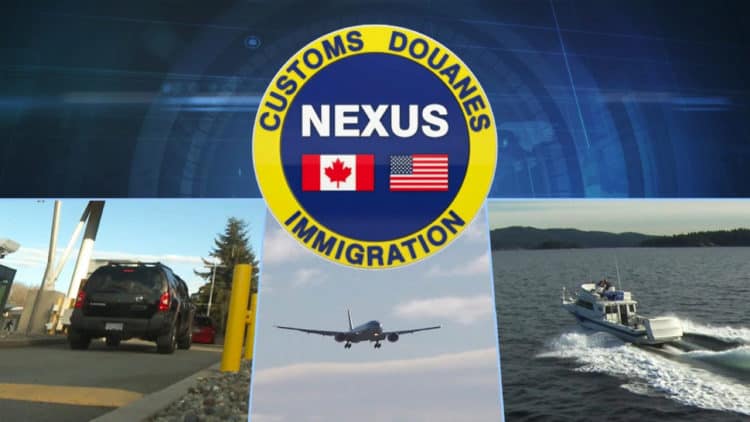
Photo: Canada Border Services Agency
Out of the five Trusted Traveler Programs, NEXUS has the most number of benefits. Here is what you get if you become a member.
Global Entry Access When Flying Into The United States
NEXUS members have full access to Global Entry benefits. By itself, Global Entry costs $100 for five years, so this is a great deal. With Global Entry, NEXUS members enjoy expedited entry through customs when returning to the United States.
TSA PreCheck Access When Flying From a United States Airport
Since TSA PreCheck is included with Global Entry, certain NEXUS members also have access to PreCheck lanes when flying from United States airports. To access PreCheck lanes, simply enter your PASSID in the Known Traveler Number Field when booking your airline reservation. You should also enter your PASSID in your Frequent Flyer Profile so it automatically fills it in for future bookings. Only U.S. citizens, U.S. lawful permanent residents, and Canadian citizens are eligible to receive PreCheck through NEXUS. Children 12 and under can use PreCheck lanes with you even if they are not NEXUS members.
The Vacationer Tip
Sign up for NEXUS to get all of the benefits of Global Entry and TSA PreCheck while also enjoying expedited entry into Canada.
NEXUS Kiosks When Flying Into Canada
After arriving to Canada by air, NEXUS members can use a self-service kiosk to verify their identity and answer a few questions. These lines are usually much shorter than the traditional ones, so the border clearance process will be quicker. After completing the process, collect the printed receipt and show it to the border agent on the way out.
Trusted Traveller CATSA Security Line Access When Flying From a Canadian Airport
NEXUS members have access to expedited security screenings at 16 Canadian airports. For those from the United States, it is similar to TSA PreCheck. You can keep your shoes, light jacket, and belt on as well as leave small items in your pocket. You may leave approved liquids in your carry-on bags. Members must remove laptops or other computing devices from their carry-on bag, however. You must have your NEXUS card to access the special security lanes.
Dedicated NEXUS Lanes For Land Entry Into The United States and Canada
With Global Entry, you can only access NEXUS lanes when driving into the United States from Canada. With NEXUS, you can access the special lanes when driving into the United States and Canada for faster entry into both countries.
Expedited Sea Access Via Telephone Reporting
NEXUS allows those arriving by sea to call a marine telephone reporting center upon arrival to the United States or Canada. This must be done at least 30 minutes in advance of your arrival.
How Much Does NEXUS Cost?
NEXUS has a $50 non-refundable application fee. Even if you are denied, you will not get the $50 back. Every member of your traveling party must be a NEXUS member to use the service, including children. Those under the age of 18 do not have to pay an application fee.
You may pay the $50 application fee via credit card or electronic bank transfer before completing your application. Previously, Canadian Processing Centers accepted paper applications, but it is online-only now. If accepted, your membership will be valid for five years.
Starting October 1, 2024, NEXUS’ application fee will increase from $50 to $120 for a five-year membership.
Credit Cards Offering Reimbursement For The $50 Application Fee :
Prior to 2021, no credit cards offered reimbursement for the NEXUS application fee. Thankfully, that has changed, and there are a variety of cards offering reimbursement for the $50 application fee. Here are a few notable ones.
Aeroplan® Credit Card (every four years; $95 annual fee)
Chase Sapphire Reserve® (every four years; $550 annual fee)
IHG® Rewards Premier Business Credit Card (every four years; $99 annual fee)
IHG® Rewards Premier Credit Card (every four years; $99 annual fee)
Southwest® Rapid Rewards® Performance Business Credit Card ($199 annual fee)
United℠ Explorer Card (every four years; $0 annual fee first year, then $95 per year)
United Club℠ Infinite Card (every four years; $525 annual fee)
United Quest℠ Card (every four years; $250 annual fee)
See our full article on the Best Credit Cards Offering a NEXUS Application Fee Credit .
NEXUS Eligibility
NEXUS is for low-risk U.S. citizens, U.S. lawful permanent residents, Canadian citizens, Canadian permanent residents, and Mexican nationals (Viajero Confiable members). Proof of citizenship and residence are required for approval. Children under the age of 18 require parental consent to be eligible.
Permanent Legal Resident Information
To apply as a permanent resident from the United States or Canada, you must have had your status for at least three years from the date of your application. Here are three exceptions to the three-year rule.
- You are serving in the United States armed forces in a foreign country
- You have a family member in the United States or Canadian armed forces serving in a foreign country
- You have a family member serving at a United States or Canadian consular post or diplomatic mission in a foreign country
Reasons for Ineligibility
Reasons for ineligibility include the following.
- Lying on the application or intentionally omitting information
- Found guilty of a criminal offense or have pending charges or warrants
- Found to have violated customs, immigration or agriculture regulations or laws
- Under investigation by law enforcement
- Inadmissible to the United States under immigration regulation
- Cannot prove to the CBP and CBSA that you are a low-risk applicant
Criminal offenses include drinking and driving. As the Canada Safety Council reports , Canada has some of the strictest drinking and driving laws in the world. Depending on the date and your BAC level, it may be difficult to get approved if you have a DUI on your record. Even if the United States approves your application, Canada may deny it.
The Vacationer
Be completely truthful and transparent when filling out your NEXUS application. You will be going through a thorough background check, so officers from the United States and Canada will find any lies or omissions.
NEXUS Enrollment Centers
All of the NEXUS enrollment centers are located near the United States/Canada border. Agents from both countries are located at each enrollment center, so you only need to schedule one interview. Here are the locations currently accepting interviews.
United States Locations
United states nexus enrollment centers, canada locations, canada nexus enrollment centers, applying for nexus.
Applying for NEXUS is simple, but you should gather a few documents beforehand. The application process should take you around 20 minutes, and payment is due before submitting your application. Remember, only U.S. citizens, U.S. lawful permanent residents, Canadian citizens, Canadian permanent residents, and Mexican nationals may apply.
The entire process from filling out the application to getting your NEXUS card after getting approved varies. Depending on the backlog, it can take as little as a few weeks to as long as six months. In some situations, it could take longer than six months. If you are truthful on your application and do not have a criminal history, it should be quicker.
Required Documents
Proof of United States or Canadian Citizenship
- Valid United States or Canadian Passport
- United States or Canadian Birth Certificate and Photo Identification
- United States Citizen Certificate or Canadian Citizen Certificate/Card
- Certificate of Naturalization or Border Crossing Card (U.S Only)
- Certificate of Indian Status (Canada Only)
Proof of United States or Canadian Permanent Resident Status
- Valid United States or Canadian Permanent Resident Card
- Record of Landing (Canada Only)
For Mexican Nationals
- Must be a member of Viajero Confiable
- Valid Passport
- If applicable, a valid work or study permit
Proof of Current Residency (1 is needed)
- Valid and Unexpired Driver’s License
- Bill or Bank Statement Showing Current Address
- Provincial ID
Fill Out The Application Online
After gathering the necessary documents, go to the Trusted Travelers Program website . In the programs list, find NEXUS and click Get Started.
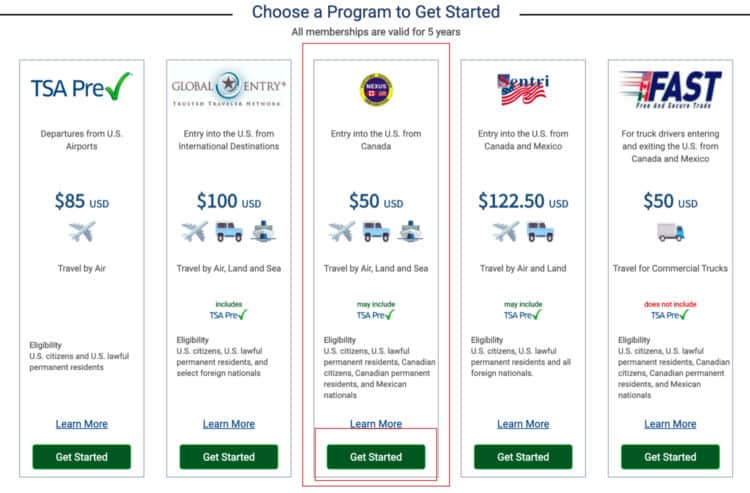
Photo: Department of Homeland Security
If you do not already have one, create a Trusted Travelers Account. Fill out your profile with basic information such as your name, date of birth, country of birth, and phone number. It is important to enter your name exactly how it appears on your passport.
Verify your citizenship, and choose NEXUS in the Available Programs area. As previously discussed, it will show the following requirements necessary for approval.
- U.S. Customs and Border Protection and the Canada Border Services Agency Approval
- Interview at an enrollment center at a United States/Canada land border or a major airport in Canada. You will be interviewed by both countries.
After agreeing to a background check, you can begin filling out the NEXUS application. It is important to be truthful and transparent. Lying on the application will get you denied.
You will enter your gender, eye color, height, and any other names you may have previously used. After filling out basic details, you will then add documents to prove your citizenship and proof you can enter the United States.
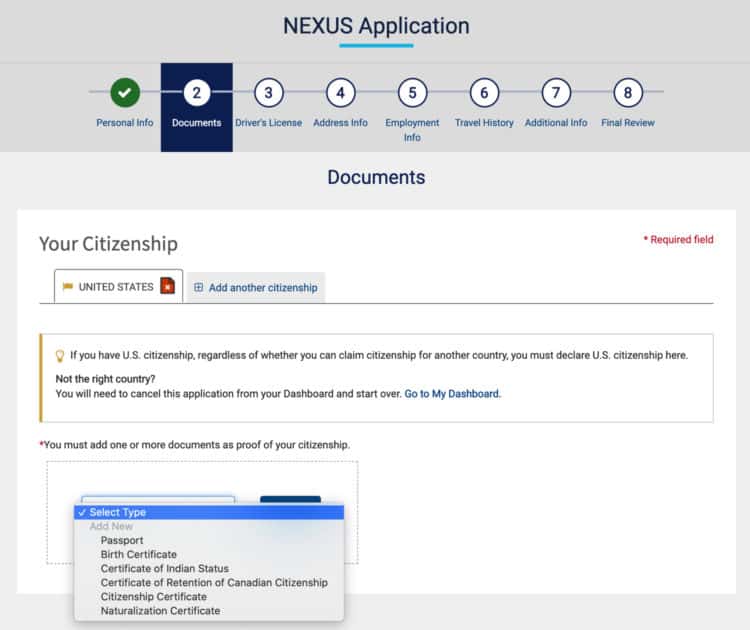
Continue filling out the application by entering your driver’s license information, current and previous addresses, employment information, travel history, and a few background questions. You will be asked whether or not you have been convicted of a crime in any country and not received a pardon. You will also be asked whether or not you have received a waiver of inadmissibility to the U.S. from a U.S. government agency. Again, be honest when answering these questions.
Review your application for accuracy. If everything looks good, click continue and pay the $50 non-refundable application fee.
Conditional Approval and Scheduling Your Interview
Conditional approval times vary considerably depending on the applicant and the number of other applications. Some people are conditionally approved in less than a week, while others are not approved for many months. After you are conditionally approved, you will receive an email alert. Your Trusted Travelers Account will note you are conditionally approved, and you will be able to schedule an interview. You cannot schedule an interview until you receive conditional approval. After conditional approval, you will have 30 days to schedule your interview.
There are a variety of locations in the United States and Canada to schedule your interview . As this is a joint program run by the CBP and CBSA, all of the enrollment centers are located near the northern border. Both the CBP and the CBSA will interview you, so you do not need to schedule separate interviews.
Children under the age of 18 must have a parent or guardian with them during their interview.
Interview Tips
The interview is to verify the accuracy of your information and documents. You have already been conditionally approved at this point, so try not to stress too much. Be sure to bring all of the documents you used when originally applying to verify your citizenship, residency, and proof of address. It is better to be over-prepared in this case.
During the interview, you will be asked a variety of questions. Depending on the complexity of your application, it may take only a few minutes or it may take a half-hour or longer. Here are a few common questions you may be asked.
- Why are you applying for a NEXUS card?
- Where have you traveled recently?
- What do you do for work?
- Has any of the personal information changed since submitting your application?
- Have you ever brought something you should not have when crossing the border?
- Have you been convicted of any crimes?
- Will you be using your NEXUS card for business use as well as personal travel?
If approved, the officer(s) will take a digital photograph of you. They will also take your fingerprints and take a photograph of your irises for identification when using the kiosks. While iris recognition technology is still used, it is being replaced by facial recognition technology. They will explain how to use your NEXUS card to enter the United States and Canada.
Using Your NEXUS Card
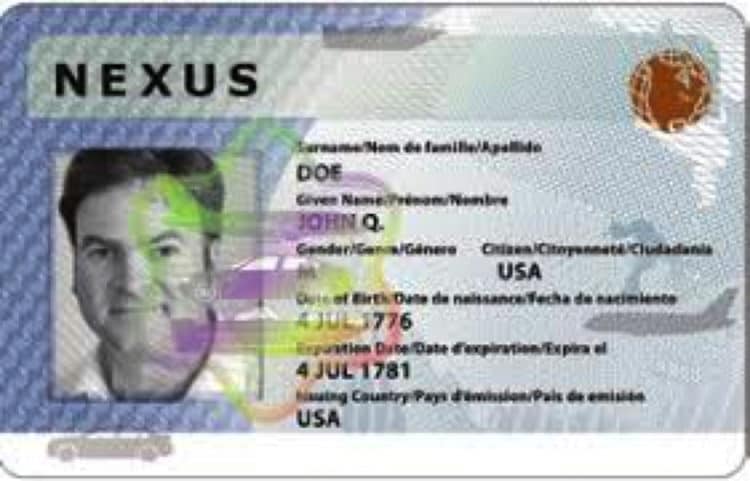
Photo: U.S. Customs and Border Protection
The NEXUS card is your ticket to accessing all of the benefits the program has to offer. It is a radio frequency identification card that is also WHTI compliant. Additionally, it is considered a REAL ID , so you can use it to fly if you do not have a compliant driver’s license yet. Please note, you cannot use NEXUS if you are entering Canada with $10,000 or more. Here is how to use it to travel between the United States and Canada via air, land, and sea.
Entering the United States :
If you are entering the United States by air from a Canadian airport with a U.S. preclearance area, you may use your NEXUS card. You can do this by using your NEXUS card at the Global Entry kiosk in the preclearance area.
If you are flying from a Canadian airport without a U.S. preclearance area or any other airport in the world, you must use your passport or permanent resident card at the Global Entry kiosks. NEXUS members entering the United States may only have personal items and no commercial goods. See our Global Entry guide for a full list of United States airports with kiosks. Here are Canadian airports with U.S. preclearance areas .
- Calgary International Airport (YYC)
- Edmonton International Airport (YEG)
- Halifax Robert L Stanfield International Airport (YHZ)
- Montréal Pierre Elliott Trudeau International Airport (YUL)
- Ottawa Macdonald-Cartier International Airport (YOW)
- Toronto Pearson International Airport (YYZ)
- Vancouver International Airport (YVR)
- Winnipeg James Armstrong Richardson International Airport (YWG)
Entering Canada:
NEXUS members entering Canada by air may use the NEXUS kiosks with their card. Remember, only NEXUS members can use the kiosks (that includes children). U.S. lawful permanent residents and Mexican nationals must have an Electronic Travel Authorization (eTA) to use NEXUS when entering Canada by air. You do not have to complete a paper CBSA declaration form when using a NEXUS kiosk. A photograph of your iris must be in the system to use NEXUS kiosks. The following Canadian airports currently have NEXUS kiosks .
- Billy Bishop Toronto City Airport (YTZ)
- Halifax Stanfield International Airport (YHZ)
- Montreal Pierre Elliott Trudeau International Airport (YUL)
NEXUS Land Border Locations :
Please note, one or more of the lanes listed may be United States or Canada bound only.
Current Land Border Crossing in The United States and Canada
Entering the United States from Canada:
Use the special NEXUS lane to enter the United States at one of the land border crossings . Simply hold your NEXUS card in front of the card reader. You will then undergo a visual inspection. All personal goods will be orally declared to a CBP officer.
Ensure every person in your vehicle is a NEXUS member if you are using the special lane to enter the United States or Canada. If someone is not a NEXUS member — and that includes children — you risk losing your membership.
Entering Canada from the United States:
Use the special NEXUS lane to enter Canada at one of 21 land border crossings . Hold your NEXUS card in front of the card reader. After a visual inspection, the officer will either allow you to enter Canada or make you undergo further inspection. Ensure every person in your vehicle is a NEXUS member.
United States and Mexican NEXUS members may make an oral declaration when entering Canada. Canadian residents may use a Traveller Declaration Card (TDC). If you have commercial goods or goods that may be restricted or require a permit, you may not use the NEXUS lane. You cannot use the NEXUS lane if you have over $10,000 in currency.
Entering the United States from Mexico :
NEXUS members can use SENTRI lanes to enter the United States from Mexico. Only registered and approved vehicles are allowed to use the SENTRI lanes, however. You can add your vehicle to your Trusted Traveler Account for a $42 fee if you did not add it when you initially applied for a NEXUS membership.
Use your NEXUS membership to access one of the over 400 marine reporting sites when entering the United States or Canada. If you are in charge of the boat, you are considered the boat master. You will communicate with the border officers as well as declare everyone’s goods. Every single person on your boat must be a NEXUS member to use a marine reporting site, and that includes children.
You must report your arrival via phone at least 30 minutes and no longer than four hours in advance. Those entering the United States should use this list to find the phone number to use. Those entering Canada should call 1 866-99-NEXUS .
The boat master must report the following information.
- Name, citizenship information, residency, DOB of everyone on board.
- The boat’s ETA
- The boat’s name and registration number
- The boat’s landing site and location of arrival
- Purpose and length of the trip for each passenger
- Passport and Visa details for each passenger
As the boat master, you should have everyone’s photo identification and proof of citizenship/residency. You are also responsible for declaring goods and currency.
NEXUS cards are a WHTI compliant document. This means it can be used by U.S. citizens in place of a passport to enter the United States from any country within the Western Hemisphere. It is also a REAL ID.

NEXUS Vs. Global Entry
Global Entry is a popular program for low-risk travelers to expedite entry through customs when returning to the United States via air, land, and sea. It has a $100 application fee, but many credit cards provide full reimbursement. It also includes TSA PreCheck , which is one of the program’s main benefits.
NEXUS includes Global Entry and TSA PreCheck, but it does have a few drawbacks. While cheaper, its $50 application fee is not reimbursed by any credit cards. NEXUS also only has enrollment centers near the border. Global Entry has enrollment centers throughout the United States, which makes it a more realistic option for those living in southern states.
Global Entry allows access by land into the United States via NEXUS and SENTRI lanes, but it does not allow expedited access to Canada. NEXUS provides its members with expedited land access to both countries, which is important for those who drive back and forth often.
If you live near the northern border and travel to Canada often, we recommend NEXUS. If you do not see yourself traveling to Canada or just cannot get to an enrollment center, Global Entry is a great alternative. Either way, both programs can help to relieve travel-related stress and anxiety when flying into the United States and Canada.
NEXUS has a $50 non-refundable application fee. No credits cards currently reimburse the application fee. Children under 18 are not subject to the application fee.
NEXUS memberships are valid for five years after which you can renew for another five years. You should begin the renewal process 90 days prior to your expiration date.
Yes. NEXUS members can take advantage of expedited entry into the United States via air with Global Entry and expedited security screenings when flying from a United States airport with TSA PreCheck. Only U.S. citizens, U.S. lawful permanent residents, and Canadian citizens are eligible for TSA PreCheck, however.
U.S. citizens, U.S. lawful permanent residents, Canadian citizens, Canadian permanent residents, and Mexican nationals (Viajero Confiable members)
No. NEXUS members may be subject to additional screenings and inspection.
Paper applications are no longer accepted. You must apply online.
To use NEXUS lanes, everyone in your party must be a member.
Your membership number is located on the back of your NEXUS card. You can also find it in the upper right corner of your online Trusted Travelers Account.
Most pets are allowed to go through NEXUS lanes. For animals over three months old, you must have your pet’s rabies vaccination certificate with you. It must identify the animal as well as include information about the vaccine used. Pet birds and animals used for commercial purposes may not use NEXUS lanes.
Yes. NEXUS cards are REAL IDs accepted by the TSA.
You cannot use NEXUS airport kiosks, go through NEXUS land border lanes, or use NEXUS marine crossings with non-members. You also cannot use NEXUS if you are crossing the border with $10,000 in currency or other monetary instruments.
The Vacationer’s Final Thoughts + Cheat Sheet
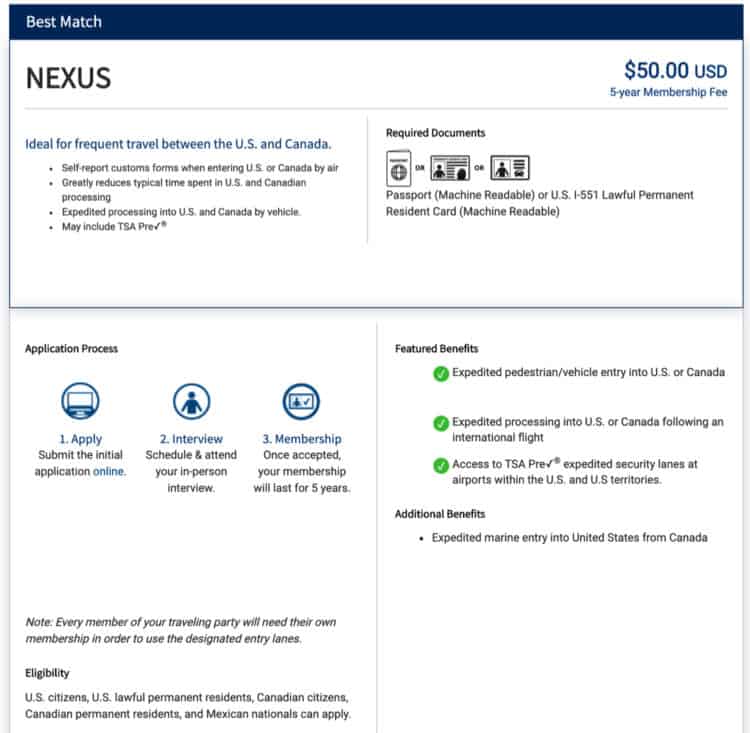
We recommend NEXUS to those looking for expedited entry into Canada while also desiring the benefits of Global Entry and TSA PreCheck. No credit cards currently cover the $50 application fee, but it is well worth the $10 per year if you are a frequent traveler. The potential drawback is enrollment centers are only located near the United States and Canada border, so take that in mind before applying.
Editorial Disclosure: Opinions expressed here are author’s alone, not those of any bank, credit card issuer, hotel, airline, or other entity. This content has not been reviewed, approved or otherwise endorsed by any of the entities included within the post.
Featured Image via U.S. Customs and Border Protection

By Phil Dengler
In addition to being a co-founder of The Vacationer, Phil Dengler is also the head of editorial and marketing. Previously, he ran a popular holiday deals website where he was a trusted source for all things Black Friday. With The Vacationer, Phil combines his knowledge of deals with his love of travel to help you plan the perfect vacation.
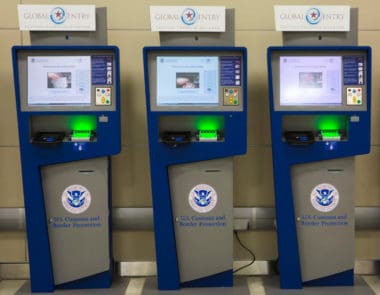
Global Entry Program – Application, Cost, Benefits, Renewal, & Airports in 2024
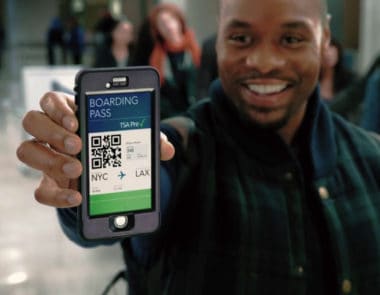
TSA PreCheck – Cost, Renewal, Locations, Application, Benefits, Airports, & Airlines in 2024
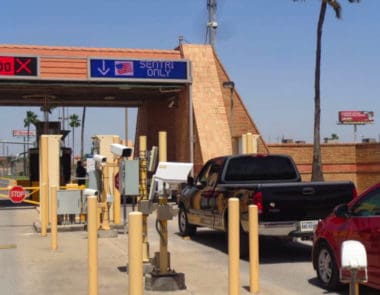
SENTRI Trusted Traveler Program Guide 2024 – Applying, Cost & Tip

An official website of the United States government
Here’s how you know
Official websites use .gov A .gov website belongs to an official government organization in the United States.
Secure .gov websites use HTTPS A lock ( Lock A locked padlock ) or https:// means you’ve safely connected to the .gov website. Share sensitive information only on official, secure websites.
- Border Security
Trusted Traveler Programs
Trusted Traveler Programs (TTP) provide modified screening for preapproved members. The programs improve security by being more efficient during screenings, and facilitate legitimate trade and travel at ports of entry. They allow members to use expedited lanes at the U.S. airports, and when crossing international borders.
Use the tool on the Trusted Traveler Programs website to find the right program for you, or to learn more about all of the Trusted Traveler Programs that DHS offers.
TSA PreCheck®
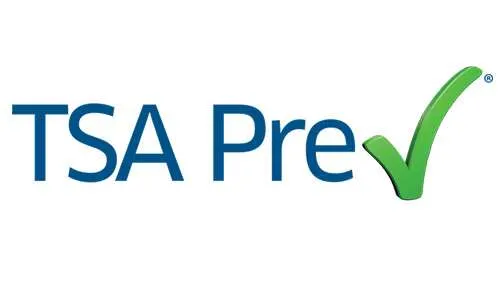
The TSA PreCheck ® program expedites traveler screening through participating TSA security checkpoints.
- Global Entry
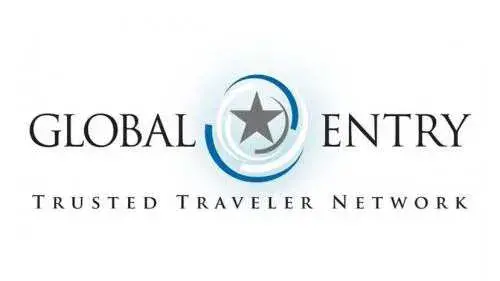
Global Entry allows expedited clearance for pre-approved, low-risk travelers upon arrival in the U.S.
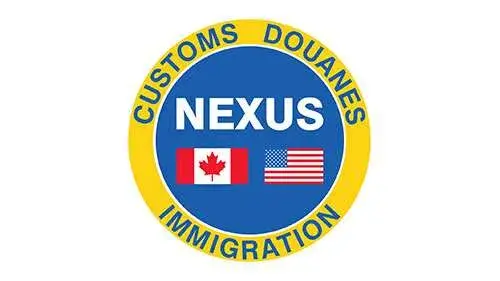
The NEXUS program allows pre-screened travelers expedited processing when entering the U.S. and Canada.
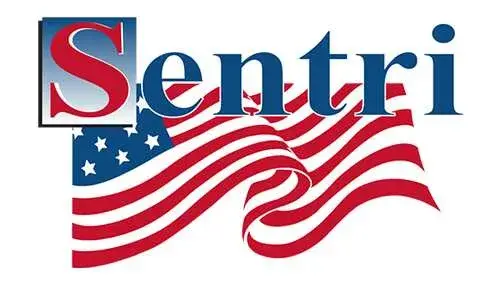
The Secure Electronic Network for Travelers Rapid Inspection (SENTRI) is a program that allows expedited clearance for pre-approved, low-risk travelers upon arrival in the U.S.
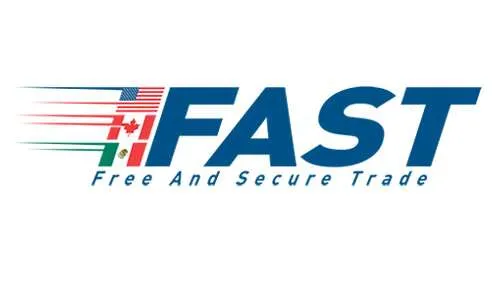
The Free and Secure Trade (FAST) is a commercial clearance program for known low-risk shipments entering the U.S. from Canada and Mexico.
- Trusted Traveler
- Trusted Traveler Comparison Tool
- TSA PreCheck
- Credit cards
- View all credit cards
- Banking guide
- Loans guide
- Insurance guide
- Personal finance
- View all personal finance
- Small business
- Small business guide
- View all taxes
You’re our first priority. Every time.
We believe everyone should be able to make financial decisions with confidence. And while our site doesn’t feature every company or financial product available on the market, we’re proud that the guidance we offer, the information we provide and the tools we create are objective, independent, straightforward — and free.
So how do we make money? Our partners compensate us. This may influence which products we review and write about (and where those products appear on the site), but it in no way affects our recommendations or advice, which are grounded in thousands of hours of research. Our partners cannot pay us to guarantee favorable reviews of their products or services. Here is a list of our partners .
Nexus vs. Global Entry: Which Is Better?
Many, or all, of the products featured on this page are from our advertising partners who compensate us when you take certain actions on our website or click to take an action on their website. However, this does not influence our evaluations. Our opinions are our own. Here is a list of our partners and here's how we make money .
Table of Contents
Global Entry vs. Nexus at a glance
Global entry, which is better: global entry or nexus.
After a red-eye flight or a long car ride, it's not ideal to be stuck in a long line at customs or the border. A trusted traveler program like Global Entry or Nexus can get you where you're going faster.
The main difference between Global Entry and Nexus is that Global Entry allows for expedited reentry to the U.S. when returning from any country abroad. On the other hand, Nexus allows expedited passage between the U.S. and Canada.
Global Entry and Nexus also differ in who is eligible for the programs. Global Entry is available to citizens of the U.S. and 14 other countries, while Nexus is available to citizens and residents of the U.S. and Canada (and Mexican nationals).
All Nexus members are eligible for Global Entry benefits —and TSA PreCheck benefits — as long as their passport and fingerprints were collected at the enrollment interview. The catch is that to get a Nexus membership, you need to go for an in-person interview. The interview locations are along the U.S.-Canada border and at major airports in Canada, so proximity to an interview location may limit who can apply for Nexus.
The programs share other similarities and also some differences. Here's a look at Global Entry versus Nexus.

This chart shows the difference between Nexus and Global Entry.
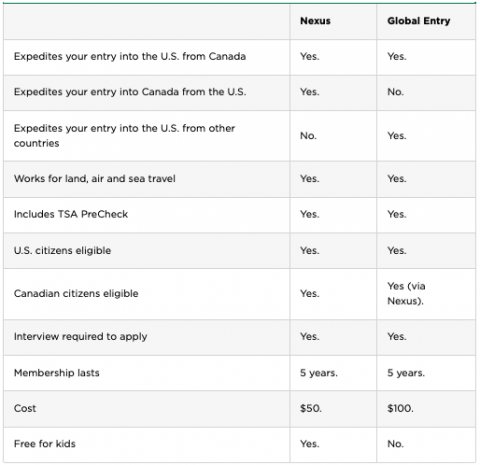
*All current Nexus members are eligible to use Global Entry kiosks once they provide fingerprints and document information to U.S. Customs and Border Protection.
» Learn more: How redress numbers work for travel
Typically, anytime you return to the United States from another country, you have to go through customs, a process with U.S. Customs and Border Protection (CBP) that includes passport checks and potentially an interview with a live agent — sometimes after standing in line for half an hour or more.
Global Entry , a program run by CBP, allows preapproved passengers who are deemed low risk to skip this process when they return to the U.S. by instead using an automated kiosk at more than 75 airports. At these entry kiosks, you'll swipe your passport, scan your fingerprints and fill out a customs declaration form — then you're done.
CBP also has Global Entry kiosks at more than a dozen international airports, allowing members returning to the U.S. to go through the required customs and immigration processes before getting on their U.S.-bound planes. Then, when they land in the U.S., they're treated as domestic travelers, bypassing the customs and immigration hassles.
Citizens from the United States and 11 other countries — as well as Mexican nationals — are eligible for Global Entry membership. To become a Global Entry member, you must fill out an application, pass an extensive background check and get interviewed in person by a CBP officer.
Airports with Global Entry kiosks
Some Global Entry-eligible U.S. airports include:
Fort Lauderdale.
Los Angeles.
New York-JFK.
Philadelphia.
If you're heading to the U.S., you may be able to use a Global Entry kiosk before you even board your flight. CBP operates these kiosks at select airports, including:
The Bahamas.
See this link for a complete list of airports with Global Entry kiosks.
How to apply for Global Entry
Ensure you're eligible by checking CBP's criteria before paying the nonrefundable $100 application fee. Some reasons for disqualification include:
Crime conviction.
Criminal charges.
Current criminal investigation.
Denial for the purchase of a firearm.
To begin the application process, create a Trusted Traveler Programs account and fill out the application online. Every traveler, including minors, must have an individual account.
CBP officials will then review your application, and if you’ve been approved, you'll be notified to schedule an in-person interview at a Global Entry Enrollment Center. Find the center nearest to you at this link .
Suppose you're flying into the U.S. from abroad after your application is approved, but your interview has not been completed. In that case, you can finalize this last step at an Enrollment on Arrival location at certain airports. The CBP recommends using an Enrollment on Arrival location for anyone traveling into the U.S. in the next six months.
No matter where you do your interview, bring your valid passport and one other form of official ID. In addition, bring your machine-readable permanent resident card if you're a lawful permanent resident. During your interview, you'll answer questions from a CBP officer, get photographed and supply biometric information like fingerprints.
Be prepared to supply other information or documents that could include:
Proof of citizenship or proof that you're allowed to enter the United States.
Driver's license.
Proof of your current address.
Address history for the past five years.
Employment history for the past five years.
International travel information for the past five years.
Court documents if you've ever been convicted of a crime other than a traffic violation.
Vehicle information if you plan on driving into the U.S. from Mexico.
What happens after you apply for Global Entry?
Once you fill out your application, it can take between four to six months or more to get final approval. Once approved, you'll be issued a Global Entry Card with your nine-digit CBP PASSID. You can also find this number anytime by logging in to your Trusted Traveler account.
You'll enter this number in the Known Traveler Number (KTN) field when you book plane tickets. For example, here is American Airlines' booking page showing the field where you enter your PASSID number.
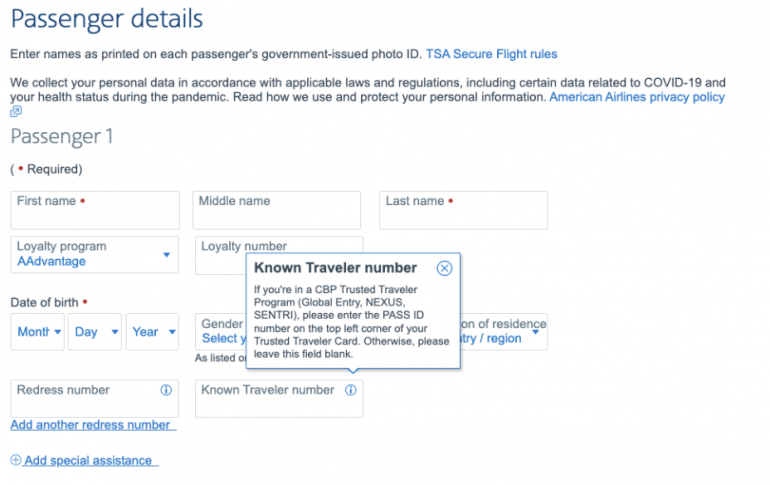
Alternatively, you can add the KTN to your frequent flyer profile so that the number will be automatically included on your reservation. You’ll need to do this for each airline’s frequent flyer account.
» Learn more: What is a Known Traveler Number?
Global Entry cost
Global Entry costs $100 for a five year membership. You can renew your membership during the fourth year.
Many popular travel cards like the The Platinum Card® from American Express reimburse the $100 Global Entry application fee, and the renewal fee during your fourth year. Terms apply.
Other cards that offer Global Entry or NEXUS credits include:

on Bank of America's website
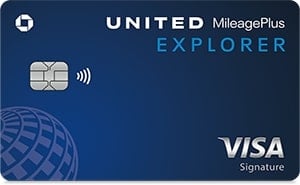
on Chase's website

$0 intro for the first year, then $95 .
Statement credit of up to $100 as reimbursement when you charge the application fee for TSA PreCheck or Global Entry to the card. Available once every 4 years.
Statement credit of up to $100 as reimbursement when you charge the application fee for TSA PreCheck, Global Entry or NEXUS to the card. Available once every 4 years.
» Learn more: Best credit cards for TSA PreCheck and Global Entry
Does Global Entry include TSA PreCheck?
TSA PreCheck is one of the benefits included with Global Entry. TSA PreCheck is a separate traveler program that allows you to wait in a designated (and usually shorter) security line before you enter the gate area. The TSA PreCheck line is generally faster than the standard security line because you don’t need to remove your shoes or belt, or take out your laptop or liquids from your bag.
So, by getting Global Entry membership, not only do you get expedited reentry when you return to the U.S. from traveling abroad, but you also get access to the separate TSA PreCheck line at the airport.
Depending on where you're traveling from, your boarding pass should show the TSA PreCheck logo if your KTN was on your reservation. If the logo doesn't print on your boarding pass, you'll have to go through the regular TSA screening lane (or go back to check-in to add your KTN). You can't just show your Global Entry Card at airport security to access the TSA PreCheck lane.
» Learn more: Is TSA PreCheck worth it?
Nexus is a joint program of the U.S. and Canadian governments, making it easier for low-risk travelers to pass back and forth across the border. Citizens and residents of the U.S. and Canada, as well as Mexican nationals who are members of Mexico’s trusted traveler program Viajero Confiable, are eligible to apply.
Your Nexus membership can help you bypass hassles at the border, whether traveling by plane, car, boat or even on foot. If you frequently travel between the U.S. and Canada, you don't need to bring your passport or residence card and can use your Nexus card instead as long as you cross the border at the following locations: the U.S. and Canadian land borders, Canadian airports, and U.S. airports with Canada pre-clearance locations only.
Nexus by air, land and sea
Members can use Nexus kiosks to enjoy expedited entry into Canada when arriving at any of nine airports:
Calgary International.
Edmonton International.
Halifax Stanfield International.
Montréal Pierre Elliott Trudeau International.
Ottawa Macdonald-Cartier International.
Toronto Pearson International.
Billy Bishop Toronto City.
Vancouver International.
Winnipeg James Armstrong Richardson International.
When flying to the United States from abroad, Nexus members enjoy Global Entry benefits at any airport with a Global Entry kiosk .
When traveling by car, Nexus members can use one of the designated Nexus lanes at any of the 21 U.S.-Canada border crossings, which are listed here (make sure to note the applicable hours and any closures). No matter which direction you're traveling, you'll present your Nexus card for electronic scanning and then proceed to visual inspection.
Everyone in your car, regardless of age, must be a Nexus member to take advantage of the Nexus lanes. You can lose your Nexus membership if you try to use the Nexus lanes with non-Nexus passengers.
If you're traveling by boat to Canada, you have to call the Nexus Reporting Centre at 866-996-3987 at least 30 minutes, but not more than four hours, before entering. If you're traveling to the U.S., you'll need to call the CBP marine reporting number for your arrival area.
Check this CBP website to find out which number to call for the specific location you’re entering. For more information on Nexus for sea travel, visit the Nexus Marine website . Like driving across the border, all individuals on board must be Nexus members to use this service.
How to apply for Nexus
American citizens can apply for Nexus through the U.S. government's Trusted Traveler Programs website . You'll create a Trusted Traveler Programs account, fill out an application, and then get interviewed in person once you pass the vetting process.
Canadian citizens and residents can apply through the Canada Border Services Agency website . It's similar to the process U.S. citizens undergo, including the online application and the required in-person interview.
What happens after you apply for Nexus?
It can take between 12 to 14 months for U.S. and Canadian authorities to approve your Nexus application.
If you're approved, you'll get a Nexus card that you must activate online. Then, when booking a flight, you'll enter your nine-digit PASSID displayed on your card, which should automatically qualify you to receive the TSA PreCheck logo on your boarding pass when traveling from U.S. airports offering TSA PreCheck.
Nexus costs $50 for a five-year membership. You need to pay the fee when applying. The fee is nonrefundable, so if you’re denied, you will not get your money back.
There are also several credit cards that reimburse NEXUS application fees.
Does Global Entry include Nexus?
Global Entry benefits are included for Nexus members. Since Global Entry costs $100 and Nexus only costs $50, signing up for Nexus is a great way to get a Global Entry membership for half the cost.
However, getting a Global Entry membership through Nexus is only convenient for those who live along the U.S.-Canada border or travel through a major Canadian airport frequently, as you will need to go for an in-person interview at a Nexus enrollment center.
Does Nexus include TSA PreCheck?
Similar to Global Entry, Nexus also includes TSA PreCheck benefits if you input your KTN into your reservation. Since TSA PreCheck (which typically costs roughly $78 - $85 for new applicants, depending on provider) is also included with NEXUS, signing up for a NEXUS membership is a great way to get TSA PreCheck at a discount.
When comparing Nexus versus Global Entry, the answer depends entirely on your travel habits. If you travel between Canada and the U.S. often, Nexus is better because it can help you in both directions. However, if you travel to many different countries (whether they include Canada or not), Global Entry is better because it speeds your entry back into the U.S.
How to maximize your rewards
You want a travel credit card that prioritizes what’s important to you. Here are some of the best travel credit cards of 2024 :
Flexibility, point transfers and a large bonus: Chase Sapphire Preferred® Card
No annual fee: Wells Fargo Autograph℠ Card
Flat-rate travel rewards: Capital One Venture Rewards Credit Card
Bonus travel rewards and high-end perks: Chase Sapphire Reserve®
Luxury perks: The Platinum Card® from American Express
Business travelers: Ink Business Preferred® Credit Card
IHG One Rewards Premier Credit Card
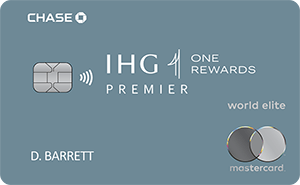
Earn 5 free nights at an IHG property after $4k in spend (each night valued at up to 60k points).

TSA Precheck vs. NEXUS: which is the best travel program for you in 2024?

Nov 28, 2023 • 14 min read

An in-depth look at two expedited security processes that cater to distinct travel needs. Which one is best for you? © Prostock-studio / Shutterstock
This series of articles about credit cards, points and miles, and budgeting for travel is brought to you in partnership with The Points Guy .
Advertiser Disclosure: This post contains references to products from one or more of our advertisers. We may receive compensation when you click on links to those products. Terms apply to the offers listed on this page. This relationship may impact how and where links appear on this site. This site does not include all financial companies or all available financial offers. All information about the credit cards from Aeroplan, American Airlines, Arvest, Bank of America, Choice Privileges, Commerce Bank, Diners Club, HSBC, Navy Federal, PenFed Pathfinder, Provident World, Truist, UBS, Visa Infinite, USAA Eagle, U.S. Bank, along with all Citi cards, the MasterCard Black Card, the MasterCard Gold Card, the American Express® Green Card, and the Capital One® Spark® Miles Card has been collected independently by Lonely Planet. These cards are not available through Lonely Planet. Terms apply to American Express benefits and offers. Enrollment may be required for select American Express benefits and offers. Visit americanexpress.com to learn more.
Navigating the tedious security and customs procedures at airports can be a source of frustration for travelers, but trusted traveler programs like TSA PreCheck and NEXUS aim to alleviate these challenges. Both programs offer expedited security processes but cater to distinct travel needs and differ in coverage and benefits. Understanding the differences between TSA PreCheck and NEXUS is essential for travelers seeking to breeze through checkpoints with ease and efficiency.
To help you navigate these two programs, we delve into the key differences and similarities between TSA PreCheck and NEXUS, covering the eligibility requirements, benefits, costs and coverage areas. By examining these programs side by side, travelers can make informed decisions about which program aligns best with their travel habits and preferences, ensuring a smoother and more expedient journey through airport security. Here’s everything you need to know about TSA PreCheck vs. NEXUS:
How to get started with travel points and airline miles

What is TSA PreCheck?
TSA PreCheck is a trusted traveler program operated by the Transportation Security Administration (TSA) in the United States. It's designed to expedite the airport security screening process for eligible passengers, providing a smoother and more efficient experience at security checkpoints. Approved travelers benefit from dedicated TSA PreCheck lanes, which usually have shorter lines and faster processing times than standard security lanes.
Participants in TSA PreCheck can keep their shoes, belts and light jackets on, and they don't need to remove laptops or compliant liquids from their carry-on bags during screening. This streamlined process helps save time and reduces the hassle associated with traditional security screenings. TSA PreCheck aims to enhance travel convenience for pre-approved and low-risk individuals, offering a more convenient way to navigate security at participating airports across the United States.
To become eligible for TSA PreCheck, travelers must apply, undergo a background check and complete an in-person appointment for fingerprinting and verification. Upon approval, successful applicants receive a Known Traveler Number (KTN) that they can use when booking flights to access TSA PreCheck benefits.
Best for: Travelers who want expedited security screenings at over 200 US airports.
How to travel to Italy with points and miles
How to apply for TSA PreCheck
To qualify for TSA PreCheck, travelers must be US citizens, US nationals or lawful permanent residents. The application process involves filling out an online application , scheduling an in-person appointment at an enrollment center for a background check, fingerprinting and paying a non-refundable fee of up to $85. Here are the steps for applying for TSA PreCheck:
- Complete the application: You can apply for TSA PreCheck online by providing the required personal information.
- Visit an enrollment location: After submitting your application, you must visit an enrollment center for a brief appointment. At this appointment, you’ll present your eligible identification document, take a photo, complete fingerprinting and pay the $50 nonrefundable application fee. Some credit cards offer statement credits when you charge the fee to these cards (more on that later).
- Get your Known Traveler Number (KTN): Upon approval, you will receive a KTN that you will need to enter when making airline reservations. Your boarding pass will have a PreCheck designation, allowing you to use the expedited security lane.
Best credit cards for airport lounge access
Credit cards that cover TSA PreCheck application fees
The TSA PreCheck application fee costs up to $85, and membership is valid for five years. While this fee is certainly reasonable, considering membership lasts five years, several credit cards offer statement credits towards this fee. These cards let you choose between a credit for TSA PreCheck or Global Entry . Since Global Entry includes PreCheck membership and only costs $22 more, it makes sense to splurge and get access to both.
Here’s a list of all the credit cards that provide a credit every four years towards TSA PreCheck application fees:
- Aeroplan® Credit Card
- American Airlines Credit Union Visa® Signature credit
- Arvest Visa Signature® Credit Card
- Bank of America® Premium Rewards® credit card
- Capital One® Spark® Miles Card
- Capital One Venture Rewards Credit Card
- Capital One Venture X Rewards Credit Card
- Capital One Venture X Business
- Chase Sapphire Reserve®
- Choice Privileges® Select Mastercard®
- Citi® / AAdvantage® Executive World EliteTM MasterCard®
- Citi Prestige® Card
- Commerce Bank® World Elite Mastercard®
- Delta SkyMiles® Platinum American Express Card *
- Diners Club® Carte Blanche® Corporate Card
- HSBC Elite World Elite Mastercard®
- HSBC Premier World Mastercard®
- IHG One Rewards Premier Credit Card
- IHG One Rewards Premier Business Credit Card
- Marriott Bonvoy Brilliant® American Express® Card *
- MasterCard® Black Card™
- MasterCard® Gold Card™
- Navy Federal's Visa Signature® Flagship Rewards Card
- PenFed Pathfinder® Rewards Visa Signature® Card
- Provident World+ Travel®
- Southwest® Rapid Rewards® Performance Business Credit Card
- Truist Business Travel Rewards credit card
- Truist Enjoy Beyond credit card
- Truist Enjoy Travel credit card
- UBS Visa Infinite Credit Card
- United Club℠ Infinite Card
- United℠ Explorer Card
- United Quest℠ Card
- USAA Eagle Navigator™ Visa Signature® Credit Card
- U.S. Bank Altitude® Connect Visa Signature® Card
- U.S. Bank Altitude® Reserve Visa Infinite® Card
- U.S. Bank FlexPerks® Gold American Express® Card*
Best credit cards for adventure travel

What is NEXUS?
The NEXUS Trusted Traveler Program is a joint initiative between the United States Customs and Border Protection (CBP) and the Canada Border Services Agency (CBSA). It aims to expedite the border clearance process for pre-approved, low-risk travelers who frequently cross the US-Canada border. NEXUS allows members to use dedicated lanes at land crossings and kiosks at airports to streamline their entry into either country.
Applicants must submit an application, pay the $50 application fee, undergo a background check and complete an in-person interview where biometric information is collected (i.e., photo and fingerprints). The application fee is waived for travelers under the age of 18. Once approved, membership is valid for five years, during which you’ll receive access to expedited lanes and kiosks when entering the US or Canada.
NEXUS members can also access Global Entry and TSA PreCheck lanes, greatly improving the overall travel experience. NEXUS members can even use the Global Entry kiosks when entering US airports and the TSA PreCheck lines when going through security checkpoints. Considering the $50 application fee is lower than both Global Entry ($100) and PreCheck (up to $85), applying for NEXUS is the best choice for frequent travel to Canada since you get access to all three programs for less. Note that the Global Entry kiosks are limited to specific Canadian preclearance locations only.
Best for: Anyone traveling frequently between the US and Canada.
Capital One Venture X review: an excellent credit card for travel enthusiasts
How to apply for Nexus
The Nexus application process is fairly straightforward. To be eligible for NEXUS, applicants can’t have a criminal record or customs violations. Applicants must be US citizens, lawful permanent residents, Canadian citizens, Canadian lawful permanent residents or Mexican nationals who are members of Viajero Confiable. Once you’ve confirmed your eligibility, you can follow these steps to apply for Nexus:
- Create an online account: Visit the CBP's Trusted Traveler Programs website and create an account.
- Complete the application: Log in to your TTP account and complete the NEXUS application form. You'll need personal information, employment history, travel history, etc. You’ll pay a $50 nonrefundable application fee. Some credit cards offer statement credits when you charge the fee to these cards (more on that later).
- Schedule an interview: After submitting your application and fee, you'll be conditionally approved if you pass the initial screening. Then, schedule an interview at a NEXUS Enrollment Center.
- Complete the interview: Bring your required documents to the interview. You will be asked questions about your application and biometric data, including fingerprints and photos.
- Wait for approval: Following the interview, your application will be further processed. If approved, you'll receive your NEXUS card by mail. Membership is valid for five years.
How to get major perks at global events and concerts with your credit card
Credit cards that cover NEXUS application fees
Many travel credit cards offer up to $100 credit towards Nexus, Global Entry or TSA PreCheck application fees. Some of these cards give you a choice between covering application fees for NEXUS, Global Entry or TSA PreCheck. These credits are renewed every four years, just in time for renewals. Here’s a list of credit cards that cover NEXUS application fees:
Best credit cards with no international fees

Comparison between TSA PreCheck and Nexus
Both programs offer expedited screening processes, but understanding their unique features and suitability for different travel needs is crucial in making an informed choice. Below is a comprehensive comparison highlighting the key differences and similarities between TSA PreCheck and NEXUS, aiming to assist travelers in discerning which program aligns best with their specific travel requirements.
TSA PreCheck: Up to $85 for five years
NEXUS : $50 for five years
Expedited security screening?
TSA PreCheck: Yes
NEXUS : Yes (TSA PreCheck lanes)
Expedited customs and border control check?
TSA PreCheck: No
NEXUS : Yes
Requires background check?
Requires fingerprinting, requires an interview, requires a valid passport.
TSA PreCheck: Travelers who want expedited security screenings at over 200 US airports.
NEXUS : Travelers who frequently travel between the US and Canada.
Chase Ultimate Rewards Guide: one of the best loyalty programs on the market
Other Trusted Traveler Programs
TSA PreCheck and NEXUS are targeted towards two very different travelers. If you find you find that neither program suits your specific needs, there are other trusted traveler programs that might be a better fit. Here’s a look at these programs and the benefits they offer:
Global Entry
Global Entry is a trusted traveler program designed to expedite the customs and immigration process for pre-approved, low-risk travelers when they arrive in the US. It's particularly beneficial for frequent international travelers, reducing the time spent waiting in line for immigration and customs clearance at select airports. Applicants approved for Global Entry are automatically enrolled in TSA PreCheck.
Eligibility for Global Entry includes US citizens, lawful permanent residents and citizens from a few select countries. Applicants must have a clean criminal record and no violations of customs, immigration or agriculture laws.
The application process involves filling out an online form, paying a $100 non-refundable fee and undergoing a background check. Once conditionally approved, applicants need to complete an in-person interview at a Global Entry Enrollment Center. During this interview, biometric data is collected and the final eligibility determination is made.
Global Entry membership lasts for five years, after which individuals can apply for renewal. Alongside expedited entry benefits, Global Entry members also receive TSA PreCheck benefits for domestic travel, making security screening at participating airports faster and more convenient. Plenty of credit cards offer TSA PreCheck application fee credits, including the Capital One Venture Rewards Credit Card and Chase Sapphire Reserve .
Best for: Frequent or occasional international travelers who want to enjoy expedited customs and immigration processing.
How to travel to Greece using points and miles

CLEAR is a trusted traveler program in the United States that focuses specifically on expediting the security screening process at airports and certain venues by using biometric technology, such as fingerprint and iris scans, to verify identity. It's a complement to TSA PreCheck and Global Entry, allowing members to skip the ID check at security checkpoints.
CLEAR is available to US citizens and permanent residents aged 18 or older with a valid government ID. There are no background checks or extensive eligibility criteria beyond meeting the age requirement and providing the necessary identification documents during the sign-up process.
The cost for a CLEAR membership is $199 per year for individuals, while families can add additional members to existing accounts for $99 per person. There are often discounts available for certain affiliations, such as airline memberships and government employees. Additionally, several credit cards offer application fee credits towards CLEAR membership. These include the United℠ Explorer Card , The Platinum Card® from American Express *, American Express® Green Card* and others.
CLEAR is especially beneficial for individuals who prioritize saving time and value a seamless airport experience. Business travelers or frequent flyers who often find themselves in a time crunch or those who travel through airports with notoriously long security lines might find CLEAR advantageous. It's also valuable for travelers who don’t have TSA PreCheck or Global Entry but still seek a quicker way through airport security.
While CLEAR doesn't replace the need for TSA PreCheck or Global Entry in terms of accessing expedited security lanes or international customs clearance, it complements these programs by focusing specifically on biometric-based identity verification, ensuring a faster passage through security checkpoints at participating airports and venues.
Best for: Frequent travelers who value speed and efficiency in passing through airport security and via CLEAR's expedited biometric identity verification.
TSA PreCheck vs. Clear: which one is best to expedite your travels?
Which should you apply for?
The choice between TSA PreCheck and NEXUS depends on your travel patterns and needs. If your primary travel involves domestic flights within the United States, TSA PreCheck might be the more suitable option. It expedites security screenings at participating US airports, allowing for a faster and smoother experience during domestic air travel. However, if you frequently travel between the US and Canada, NEXUS might be the better choice.
NEXUS not only includes TSA PreCheck benefits for US travel but also provides expedited processing at both US and Canadian borders, streamlining the customs and immigration process for land, air and sea travel between the two countries. Assessing your travel habits and preferences is key to determining which program aligns best with your needs.
Traveling to Europe using points and miles

Do I need TSA PreCheck if I have NEXUS?
If you have NEXUS, you already have access to TSA PreCheck benefits when traveling within the US and flying on participating airlines. Hence, you don’t need to apply for TSA PreCheck separately.
How to travel to Australia with points and miles
Is it better to get NEXUS or Global Entry?
Choosing between NEXUS and Global Entry largely depends on your travel patterns. If you frequently travel between the US and Canada, NEXUS offers benefits for expedited processing at both countries' borders. Meanwhile, Global Entry is more advantageous for broader international travel , providing expedited customs clearance upon entry to the United States from Canada and beyond.
How to travel to New Zealand with points and miles
Does TSA PreCheck work in Canada?
TSA PreCheck is not available in Canada, as it's administered by the US-based Transportation Security Administration.
Traveling to Hawaii with points and miles
Does Nexus include Global Entry?
NEXUS includes Global Entry benefits, offering expedited processing at both US and Canadian borders.
How to travel to Bali with points and miles
Can I get both TSA PreCheck and NEXUS?
Yes, you can have both TSA PreCheck and NEXUS memberships simultaneously.
How to travel to Spain using points and miles
* Eligibility and Benefit level varies by Card. Terms, Conditions, and Limitations Apply. Please visit americanexpress.com/ benefitsguide for more details. Underwritten by Amex Assurance Company.
Editorial disclaimer: Opinions expressed here are the author’s alone, not those of any bank, credit card issuer, airline or hotel chain, and have not been reviewed, approved or otherwise endorsed by any of these entities.
Explore related stories

Aug 22, 2024 • 8 min read
What’s the best way to explore a continent-size country? By hitting the road.

Aug 21, 2024 • 0 min read

Aug 21, 2024 • 6 min read

Aug 23, 2024 • 5 min read

Aug 22, 2024 • 9 min read

Aug 22, 2024 • 12 min read

Aug 22, 2024 • 5 min read

Aug 22, 2024 • 3 min read

Aug 22, 2024 • 0 min read

Language selection
- Français fr
Apply for, renew or replace a NEXUS card: How to apply
Fee increase coming october 1, 2024.
The NEXUS application fee will increase to US $120 for a 5-year membership.
Read this news release for details: The CBSA and U.S. CBP provide an update on the NEXUS program .
- 1. Benefits of the program
- 2. Who is eligible
- 3. What you need before you start
- 4. How to apply
- 5. After you apply
- 6. Renew or replace
Note: The CBSA no longer accepts paper application forms for the NEXUS program.
Step 1: Review privacy statements
Review Canada's privacy statement, the United States Privacy Act statement and the U.S. Federal Bureau of Investigation privacy statements before applying.
Canada's privacy statement
The information you provide in your application, including supporting documentation, and your biometric data is collected by the Canada Border Services Agency (CBSA) under the authority of the Customs Act and is protected pursuant to both the Customs Act and the Privacy Act . In accordance with Canadian laws and regulations, the information provided on your application will be shared with other government departments or agencies in Canada and the United States of America for the purpose of the operation of the NEXUS program and to conduct applicable checks and verifications to determine your eligibility and continued eligibility in the NEXUS program. If the required information is not provided, your application may not be processed and the authorization may not be granted.
Information collected for the purpose of the operation of the NEXUS program may also be disclosed within the CBSA and to other government departments or agencies, including the Royal Canadian Mounted Police and the Canadian Security Intelligence Service, for their use, in accordance with section 107 of the Customs Act .
Individuals to whom the information relates have rights of access to, correction of and protection of, their personal information under the Privacy Act . The collection, use, disclosure and retention of your personal information is described in Personal Information Bank # CBSA PPU 031. Instructions for obtaining information are provided in the CBSA's Information about Programs and Information Holdings (formerly Info Source) , which is also available at public libraries and government public reading rooms.
Individuals to whom the information relates also have the right to file a complaint to the Privacy Commissioner of Canada should they have a concern about how the CBSA handles their information. Consult the instructions for filing a privacy complaint .
U.S. Privacy Act statement
The authority to collect the information on this application, any supporting documentation, fingerprints, and other requested information is contained in Titles 8 and 19 of the U.S. Code and corresponding regulations. Furnishing the information on this form is voluntary; however, failure to provide all the requested information may be a basis for denying your application. It may also be provided to other government agencies (federal, state, local, and/or foreign) as permitted under the Privacy Act of 1974, 5 U.S.C. & 552a (2002) and other applicable law. All applicants are subject to a check of criminal information databases, immigration and customs databases, and other enforcement databases in order to determine eligibility for this program.
U.S. Federal Bureau of Investigation privacy statements
Please review these additional privacy statements:
- FBI Privacy Act Statement
- Noncriminal Justice Applicant's Privacy Rights
Step 2: Review terms and conditions
Refer to terms and conditions of the NEXUS program .
Step 3: Submit your application
You must submit your application online and pay the application processing fee through the Trusted Traveller Programs ( TTP ) System operated by U.S. Customs Border Protection ( CBP ).
To apply for NEXUS, you must:
- go to the Trusted Traveller Programs System
- choose the NEXUS program link
- sign in using your Login.gov account information
- proceed to complete your application
Exit notice
You will be leaving the CBSA website. You will link to the Trusted Traveler Programs ( TTP ) System website operated by U.S. Customs and Border Protection ( CBP ). U.S. CBP is the CBSA's partner in delivering the NEXUS program.
When you complete your application for NEXUS using the TTP System, you will be providing your personal information directly to U.S. CBP . Your information will be shared with the CBSA to determine your eligibility for NEXUS.
By continuing, you confirm that you have reviewed Canada's privacy statement and United States Privacy Act statement and agree with the use of your personal information.
Step 4: Complete the interview
The application process includes an in-person interview. For more information, refer to After you apply .
How long it will take to process your application
Your application may be processed within 30 business days of receipt. The estimated processing time only applies to properly completed applications.
This estimate does not include the scheduling of your enrolment interview. Interviews depend on the availability of appointments at enrolment centres. There is currently a significant backlog for new applicants.
Third party representatives
There are for-profit companies that offer to help you complete your NEXUS application for a cost, on top of, or beyond, the application processing fee. You do not need a third party representative to complete your NEXUS application. If you have a third party help you complete your application, you are still responsible for the information in your application.
Each application is reviewed and processed as it is received. Using a third party will not speed up the process.
Using a third party representative may result in:
- additional charges beyond the application processing fee
- delays in your membership being approved or issued
- your membership being denied

An official website of the United States government
Here’s how you know

Official websites use .gov A .gov website belongs to an official government organization in the United States.
Secure .gov websites use HTTPS A lock ( Lock A locked padlock ) or https:// means you’ve safely connected to the .gov website. Share sensitive information only on official, secure websites.

- Trusted Traveler Programs
Benefits of NEXUS
If you are approved to participate in NEXUS, you will receive a radio frequency identification card to use when entering the United States and Canada at designated NEXUS air, land and marine ports of entry.
Why You Should Join
Membership in the NEXUS program allows you to reduce your wait times at designated ports of entry by:
- using dedicated processing lanes at land border crossings,
- using NEXUS kiosks when entering Canada,
- using Global Entry kiosk when entering the United States, and
- calling a marine telephone reporting center to report your arrival into the United States and Canada

IMAGES
COMMENTS
The NEXUS program allows pre-screened travelers expedited processing when entering the United States and Canada. Program members use dedicated processing lanes at designated northern border ports of entry, NEXUS kiosks when entering Canada by air and Global Entry kiosks when entering the United States via Canadian Preclearance airports. NEXUS members also receive expedited processing at marine ...
NEXUS is designed to expedite the border clearance process for low-risk, approved travelers into Canada and the United States. By paying one fee, NEXUS members have crossing privileges at air, land, and marine ports of entry that support the program. U.S. Customs and Border Protection (CBP) and the Canada Border Services Agency (CBSA) are cooperating in this joint venture to simplify border ...
If you are approved to participate in NEXUS, you will receive a membership identification card to use when entering Canada or the United States at all designated NEXUS air, land and marine ports of entry. Remember to always travel with your passport and/or proof of permanent residence in case you are required to prove your citizenship or permanent residence status.
The Trusted Traveler Programs (Global Entry, TSA PreCheck ®, SENTRI, NEXUS, and FAST) are risk-based programs to facilitate the entry of pre-approved travelers.All applicants are vetted to ensure that they meet the qualifications for the program to which they are applying. Receiving a "Best Match" or program recommendation based on eligibility or travel habits does not guarantee acceptance ...
NEXUS is designed to speed up border crossings into Canada and the United States ( U.S.) for low-risk, pre-approved travellers. It is jointly run by the Canada Border Services Agency and U.S. Customs and Border Protection. Applicants must create an account in the U.S. Customs and Border Protection Trusted Traveller Program System to proceed.
The NEXUS application fee will increase to US $120 for a 5-year membership. Read this news release for details: The CBSA and U.S. CBP provide an update on the NEXUS program. NEXUS is designed to speed up border crossings into Canada and the United States ( U.S.) for low-risk, pre-approved travellers. It is jointly run by the Canada Border ...
Travelers can apply online for a Nexus membership, after which they'll be prompted to arrange an in-person interview at an enrollment center. Currently, there are 15 enrollment locations in Maine, Michigan, Minnesota, Montana, New York, North Dakota, Vermont, Washington and Canada. As of 2023, the average processing time for Nexus is 18 to 20 ...
The Trusted Traveler Programs (Global Entry, TSA PreCheck ®, SENTRI, NEXUS, and FAST) are risk-based programs to facilitate the entry of pre-approved travelers.All applicants are vetted to ensure that they meet the qualifications for the program to which they are applying. Receiving a "Best Match" or program recommendation based on eligibility or travel habits does not guarantee acceptance ...
NEXUS is a Trusted Traveler program between the United States and Canada. Travelers are screened by border agencies of both countries, and you are then given privileges to received expedited immigration processing when entering Canada or the United States. In the United States, you also receive Global Entry and TSA PreCheck.
The Nexus card is a great option for people who travel frequently between the U.S. and Canada. In addition to offering the same benefits as Global Entry, the Nexus card is less expensive and can ...
Are You Eligible?U.S. citizens, U.S. lawful permanent residents, Canadian citizens, Canadian lawful permanent residents and Mexican nationals who are members of Mexico's trusted traveller program, Viajero Confiable are eligible to apply for membership in the U.S./Canada NEXUS program.If you are under the age of 18, you must have your parent or legal guardian's consent to participate in the ...
The NEXUS Card interview involves answering basic questions about your NEXUS Card application as well as an iris scan and photo. You will be interviewed by two border control officers, one from Canada and one from the U.S. The interview process takes about 30 to 45 minutes but builds in wait times. Wait for 7 to 10 Days for Your Card to Arrive ...
Process to apply for, renew or replace NEXUS card. Fee increase coming October 1, 2024. The NEXUS application fee will increase to US$120 for a 5-year membership.. Read this news release for details: The CBSA and U.S. CBP provide an update on the NEXUS program.
If accepted, your membership will be valid for five years. Starting October 1, 2024, NEXUS' application fee will increase from $50 to $120 for a five-year membership. Credit Cards Offering Reimbursement For The $50 Application Fee: Prior to 2021, no credit cards offered reimbursement for the NEXUS application fee.
Trusted Traveler Programs. Trusted Traveler Programs (TTP) provide modified screening for preapproved members. The programs improve security by being more efficient during screenings, and facilitate legitimate trade and travel at ports of entry. They allow members to use expedited lanes at the U.S. airports, and when crossing international borders.
Currently, NEXUS is the cheapest option at $50; plus, children are free. TSA PreCheck costs $78 or $85 depending on the provider, and Global Entry is $100. Note that the Trusted Traveler Programs ...
Last Modified: Jun 24, 2024. Enrollment on Arrival (EoA) affords conditionally approved Global Entry and NEXUS applicants the opportunity to complete their membership eligibility determination interview upon arrival into the United States via air, including from designated U.S. Customs and Border Protection (CBP) Preclearance locations.
A trusted traveler program like Global Entry or Nexus can get you where you're going faster. The main difference between Global Entry and Nexus is that Global Entry allows for expedited reentry to ...
Considering the $50 application fee is lower than both Global Entry ($100) and PreCheck (up to $85), applying for NEXUS is the best choice for frequent travel to Canada since you get access to all three programs for less. Note that the Global Entry kiosks are limited to specific Canadian preclearance locations only.
Step 3: Submit your application. You must submit your application online and pay the application processing fee through the Trusted Traveller Programs ( TTP) System operated by U.S. Customs Border Protection ( CBP ). To apply for NEXUS, you must: go to the Trusted Traveller Programs System. choose the NEXUS program link.
Pros of NEXUS. Less expensive option than Global Entry. $50 for 5 years. Great for families as minors under the age of 18 have their application fee waived. Expedited processing through the US and Canadian border by both air and vehicle. Can use Global Entry kiosks when entering the United States.
NEXUS is designed to expedite the border clearance process for low-risk, approved travelers into Canada and the United States. NEXUS members now have crossing privileges at any air, land, and marine ports of entry that supports the program by paying one fee. U.S. Customs and Border Protection (CBP) and the Canada Border Services Agency (CBSA) are cooperating in this joint venture to simplify ...
Why You Should Join. Membership in the NEXUS program allows you to reduce your wait times at designated ports of entry by: using dedicated processing lanes at land border crossings, using NEXUS kiosks when entering Canada, using Global Entry kiosk when entering the United States, and. calling a marine telephone reporting center to report your ...